- Introduction to the walks
- Westminster
- St James’s
- Paddington to Camden Market
- City of London 1
- City of London 2
- Farringdon to Clerkenwell
- Clerkenwell to Islington
- Tower Hill to Wapping
- Wapping to Canary Wharf
- East End Sunday markets
- Charing Cross to St Paul’s
- Isle of Dogs
- Covent Garden
- About My London Walks
- Accommodation and travel tips
- Privacy policy

A walk from Tower Hill to Wapping
- This walk can be treated as the first leg of a five-hour walk from Tower Hill through Wapping and Limehouse to Canary Wharf. The introduction below takes in both halves of the full-length walk. For the second leg, please click here .
- Whilst it may be obvious, I must point out that things might have changed since I wrote this walk. This is particularly the case with the Thames Path – access points that were previously open can suddenly close, particularly when building work is taking place. London, and the riverside in the docklands in particular, are continually changing, so buildings and sights described may differ. As always, I appreciate any comments or suggestions from those who do the walk, particularly about any changes that have taken place so I can keep the walk updated. Please use the Contact page to do this. Thanks.
GETTING HERE
The walk starts at Tower Hill tube station – which is on the Circle and District lines.
Buses Number 15 stops adjacent to Tower Hill Underground station, opposite the Tower of London. The service runs from Trafalgar Square/Charing Cross station, St Paul’s Cathedral, Bank station/Queen Victoria Street and Monument station. (For details of other nearby bus routes check the Transport for London website .)
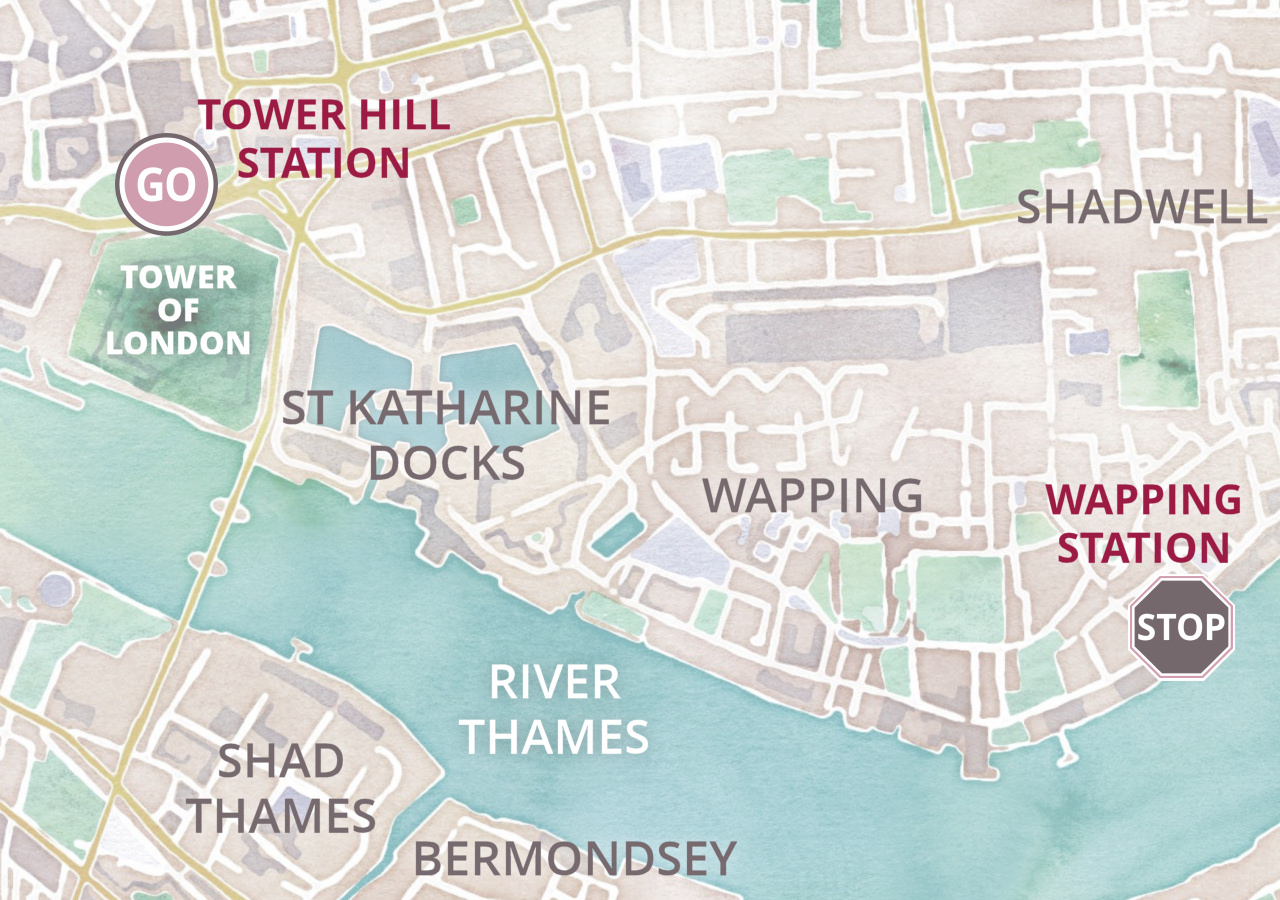
INTRODUCTION
The walk takes us eastwards from Tower Hill in the direction of Canary Wharf, passing through the once busy, but sadly always poor, riverside communities. The major industry was once shipbuilding, but later it became part of the world’s busiest port and largest complex of docks.
Since Roman times the river’s importance to London, and indeed the rest of Britain, was immeasurable, which unfortunately meant that during the Second World War it became a strategic target for the German Luftwaffe bombing raids. Indeed, there was a period of a couple of months when the bombing raids were targeting the docks and London’s East End virtually every night – and sometimes during the day as well. This resulted in vast areas of the docks, warehouses and factories, as well as the homes of tens of thousands of the people living there, being destroyed and, of course, huge numbers of deaths and casualties.
Whilst some reconstruction took place after the war this only went so far, and by the 1960s and early 70s, the number of ships coming here to unload significantly diminished.
This was a result of two things. The first was the continual labour disputes that had dogged the Port of London for many years, often resulting in bitter strikes. Much of this was caused by the shocking way the dockworkers were treated; their working conditions and pay were a constant source of justifiable grievance. The second was the advent of containerisation. Cargoes were increasingly being carried in containers which were loaded on to ever bigger ships that could no longer navigate the River Thames. So instead they were using purpose built ‘container ports’ at places such as Tilbury, further down the Thames estuary, Felixstowe or Southampton.
The result was that by the early 70s most of these riverside docks had closed, and these previously busy communities began to become almost ‘abandoned’. Many of the local people were being rehoused by London County Council in new towns further to the east of London and in Essex. In addition, there were many buildings damaged or destroyed during the bombing raids that had not been rebuilt. All of which resulted in areas of Wapping and Limehouse, for example, becoming rather sad and desolate looking.
However, it wasn’t long before a few ‘brave’ property developers (or more likely brave speculators) began to realise that some of these now derelict riverside buildings had potential for residential use.
It took a while to catch on, but by the 90s these previously abandoned and neglected warehouses alongside the River Thames – and of course in Canary Wharf and elsewhere on the Isle of Dogs – have either been renovated and turned into trendy apartments or demolished with new residential blocks built in their place.
During the walk we will see glimpses of what the area would have looked like many years ago, as well as examples of both questionable and sympathetic post-war architectural redevelopment. Sadly, preservation was not exactly top of the list of priorities for the local authorities planning departments at that time, but fortunately, more recent interest in preserving what’s left of the past has meant that preservation orders have been put on many surviving buildings and the style of more recent redevelopments has generally improved.
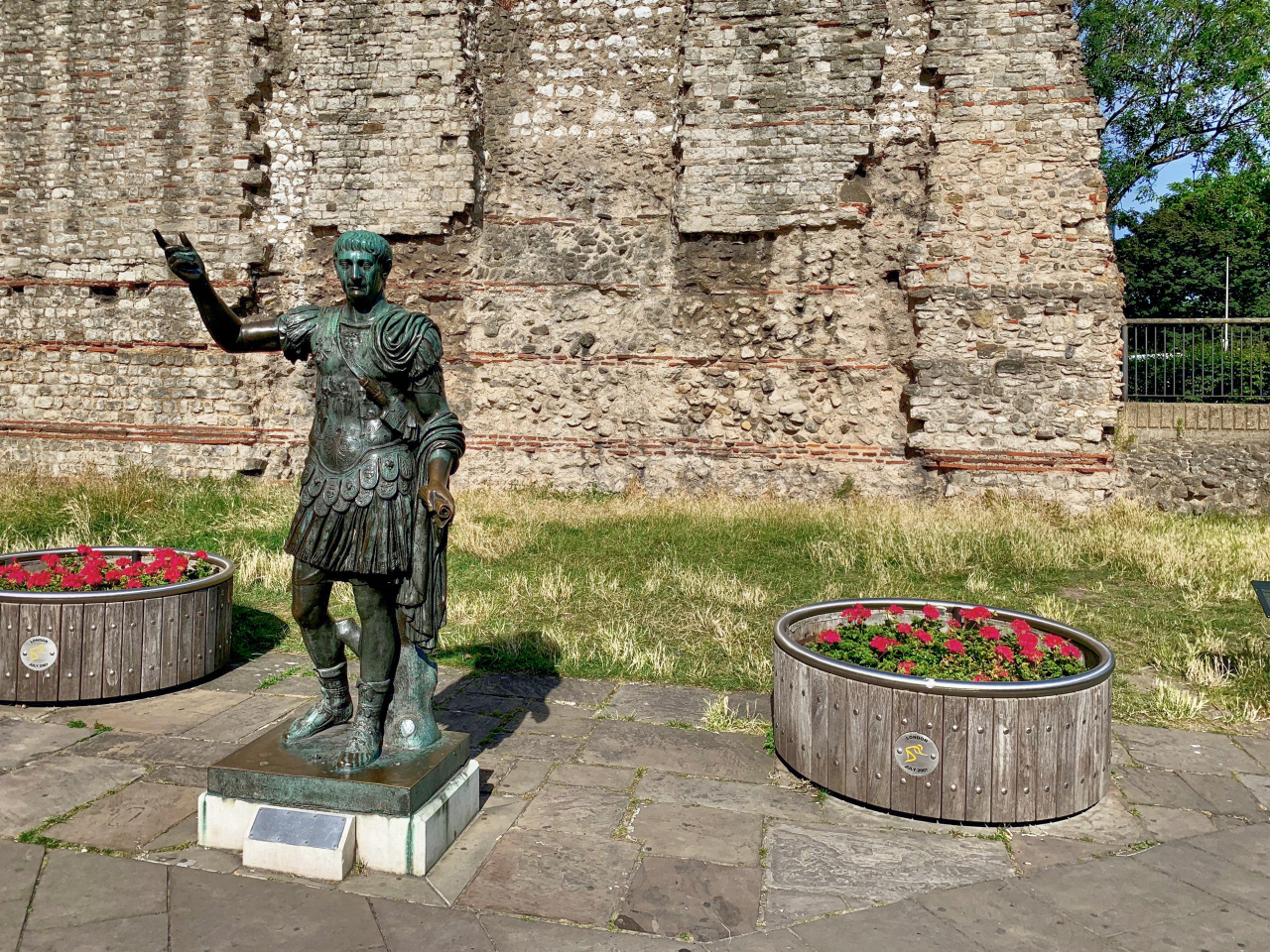
STARTING THE WALK
Upon arriving at the station exit through the ticket barrier, turn left and walk down the steps on the right, passing the lower entrance to the station, and continue towards the underpass. (However, if you leave the platform via a different exit and emerge from the newer entrance/exit then simply turn right and walk down the steps.)
As you walk down the steps, the statue you pass on your left is believed to be of the Roman emperor Trajan (98–117 AD) and behind it are parts of the original Roman wall that at one time encircled the City of London.
At the end of the underpass you pass the remains of the only surviving medieval ‘postern’ gate, which is thought to date back to the 13th century – a postern being a secondary or hidden gate, its whereabouts known only to occupants of the castle, or in this case the Tower of London.
Turn left along a pleasant path, with flowers and shrubs in the raised beds on the left and the grass moat of the Tower of London on your right. Pass the steps that lead up to the Tower Bridge Road and walk through the underpass, then turn right, passing the unusual ‘glass and scaffolding effect’ frontage of the Tower Bridge House office building.
This brings you out into the St Katharine Docks West Dock , one of the three original basins. The original warehouses on the left were demolished in the 1960s and it is now lined with restaurants you see in front of you, with offices above.
On your right you’ll see the Côte Brasserie – walk down the ramp alongside it that leads to the pontoon.
(NB – If for any reason the steps beside the Côte Brasserie and the path along the pontoon is closed, then instead simply walk straight ahead, past the line of other restaurants on the quayside and take the next turning to the right in front of the Ivory House. Pass the home of the touristy Medieval Banquets venue and at the end of the passage you will see the ‘Coronarium’ on your right – turn left and pick up the walk from here).
The enormous brick building on your right, with the large pillars is International House. This 1970s office and residential development was built to a similar design and size of the warehouse that it replaced, which gives you an idea of how huge those 19th century quayside warehouses were.
There are usually several traditional Thames sailing barges and as well as Dutch barges moored alongside the pontoon.
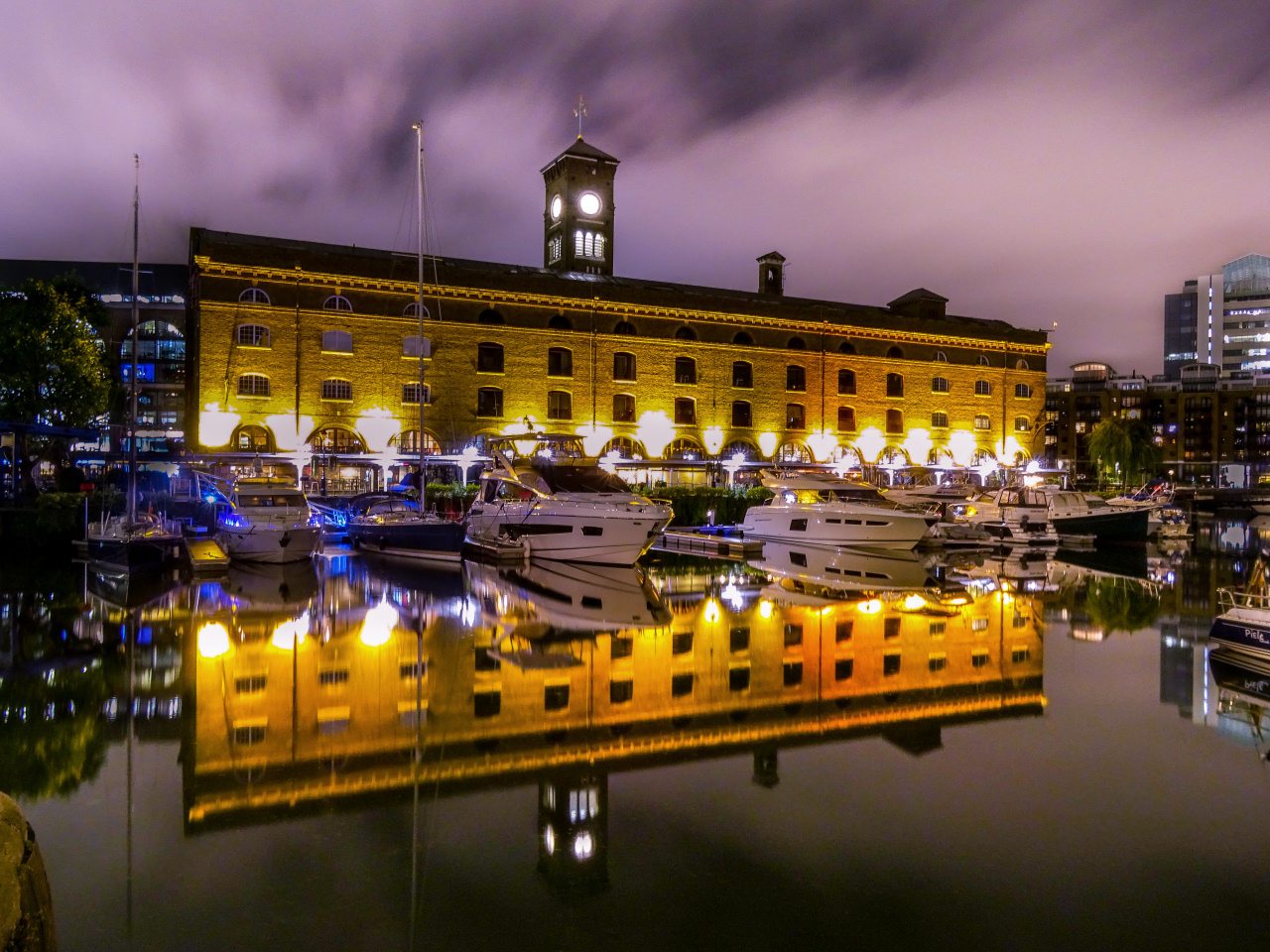
St Katharine Docks are built on the site of the ‘Royal Hospital and Collegiate Church of St Katharine by the Tower’ which was built around 1148 by Matilda, the wife of King Stephen, in memory of her two children who had died. It was to provide for a ‘Master, brethren, sisters and thirteen poor persons’, and built on land in the parish of St Botolph without Aldgate, bought for that purpose from the priory of Holy Trinity, Aldgate. For its maintenance the Queen gave the hospital a mill near the Tower of London and the land belonging to it.
It was later ‘endowed’ and granted a Charter, which reserved its patronage ‘to the Queens of England for ever’, and our Queen Elizabeth II is still a patron to this day. Its history is fascinating – it’s a ‘Liberty’ and a ‘Royal Peculiar’ – and has now relocated its ‘Mission’ to Limehouse.
Anyway, for the next 700 years it was both a religious community and hospital for people described as ‘undesirables’. These were people who weren’t allowed inside the City of London and so lived as close as possible to it. Despite the great number of people living in and around it, in 1804 the site was chosen for the building of the St Katharine Docks.
As we discover later in the walk, with the rapid increase in the number of ships bringing cargoes into London and the lack of space along the banks of the Thames to unload them, together with the enormous amount of theft taking place, ship owners and merchants had begun to open ‘inland’ docks. The first were at Wapping and on the Isle of Dogs and were so successful that more were needed, especially closer to the City of London, hence the choice of St Katharine.
This resulted in the church and the hospital, together with around 1,250 houses (or more commonly hovels) being demolished, making over 11,000 people homeless. Sadly, they were given no compensation or help in finding anywhere else to live, putting even greater pressure on the problem of homelessness in London at that time.
(For those interested in the history of St Katharine’s there is some excellent information at British History Online, sourced from the Victoria County History of London .)
St Katharine Docks
Work on building the docks started in May 1827, and a workforce of two thousand five hundred men completed the entire construction just eighteen months later. Astonishing, when you think how long it takes to build anything these days!
Like other docks built around this time, those at St Katharine were a great success, but as ships became larger it meant they were unable to pass through the entrance lock. For a few years the docks were used only by the lighters that carried cargo in from those bigger ships, but by the 1960s even that was no longer economic, and they closed.
For a few years they lay deserted until becoming a marina and leisure complex.
I’ve put a little more information about St Katharine Docks in the appendix .
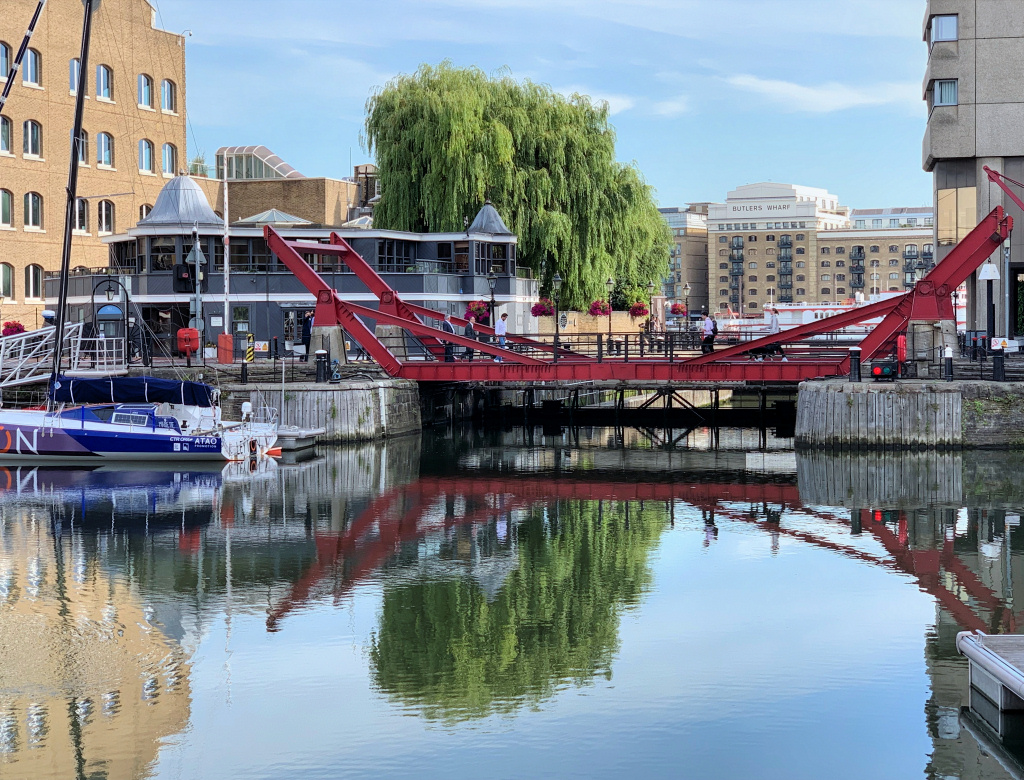
At the end of the pontoon turn left along Cloister Walk , passing the colourful murals on the rear wall of the 15-storey, 800-room Tower Hotel . It was built in the 1980s and I find it ugly (and that’s not just my view – it has twice been voted the ‘second ugliest building in London’.)
Don’t walk through the ‘arch’ under the building ahead, but turn left , (keeping the basin on your left, with a good view back across the West Dock).
Immediately in front of you is a most unusual structure – for some years a Starbucks coffee shop, then a noodle restaurant. It’s been Azimut Café London since 2021. The building was originally the ‘Jubilee Coronarium’ and despite its classically inspired design it was only erected in 1977. Designed as an open-sided ‘chapel’ to celebrate the Queen’s Silver Jubilee, its eight Doric columns were salvaged from one of the warehouses that were pulled down during the docks’ redevelopment. Interestingly, it’s said to be on the site of the original Church of St Katharine that was demolished when the docks were built.
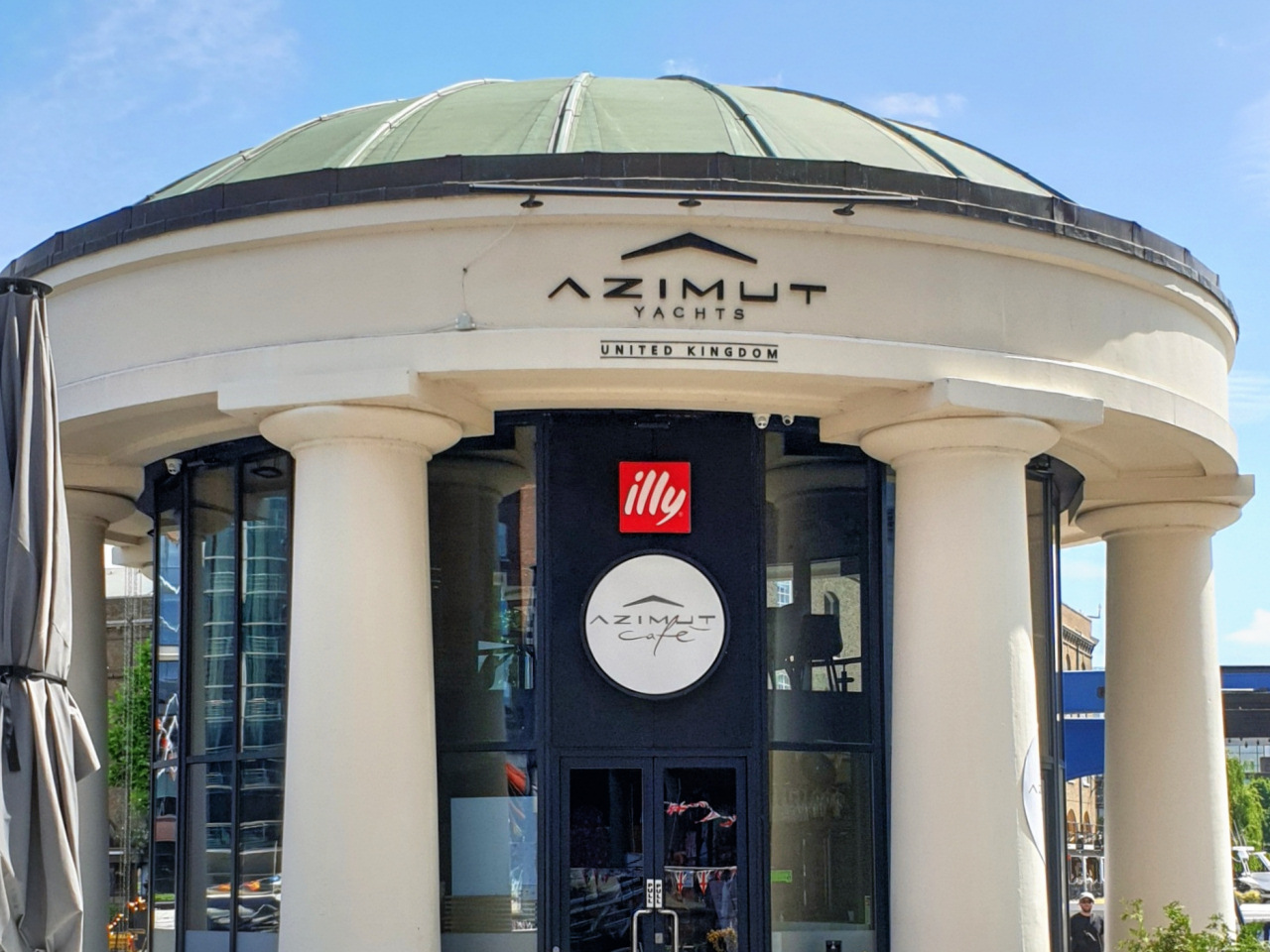
However, don’t walk on yet. Turn around and look at the wall of the building behind you, where above the cash machine you can see the ‘translucent block’ that was the original monolith created for Stanley Kubrick’s 1968 film ‘2001 – A Space Odyssey’. It had been carved out of a solid block of a type of acrylic, but when Kubrick saw it he felt that its transparency didn’t “add to the film’s mystery”, so he asked for another one to be made and this was carved from black basalt that came from Scandinavia. However, the original was never destroyed and was eventually discovered in Elstree Studios. A London-based Bratislavan sculptor bought it and when he was later commissioned to make a sculpture for the 1977 Queen’s Silver Jubilee celebrations, he carved a crown into the block.
Following its unveiling by Her Majesty the Queen on 5th June 1977, it was put on display here in the Coronarium and was moved to its current position in 2000. The plaque on it reads –
The Silver Jubilee Crystal Crown was sculpted on this site by Arthur Fleischmann KCSG, FRBS, MD, who pioneered carving in Perspex. The block measures 10’9” by 5’9” by 8” thick and weighs two tons. It is the largest solid block of Acrylic in the world. It was originally made in 1968 for Stanley Kubrick’s film “2001 – A Space Odyssey”, but was rejected by the director in favour of the now famous black basalt monolith.
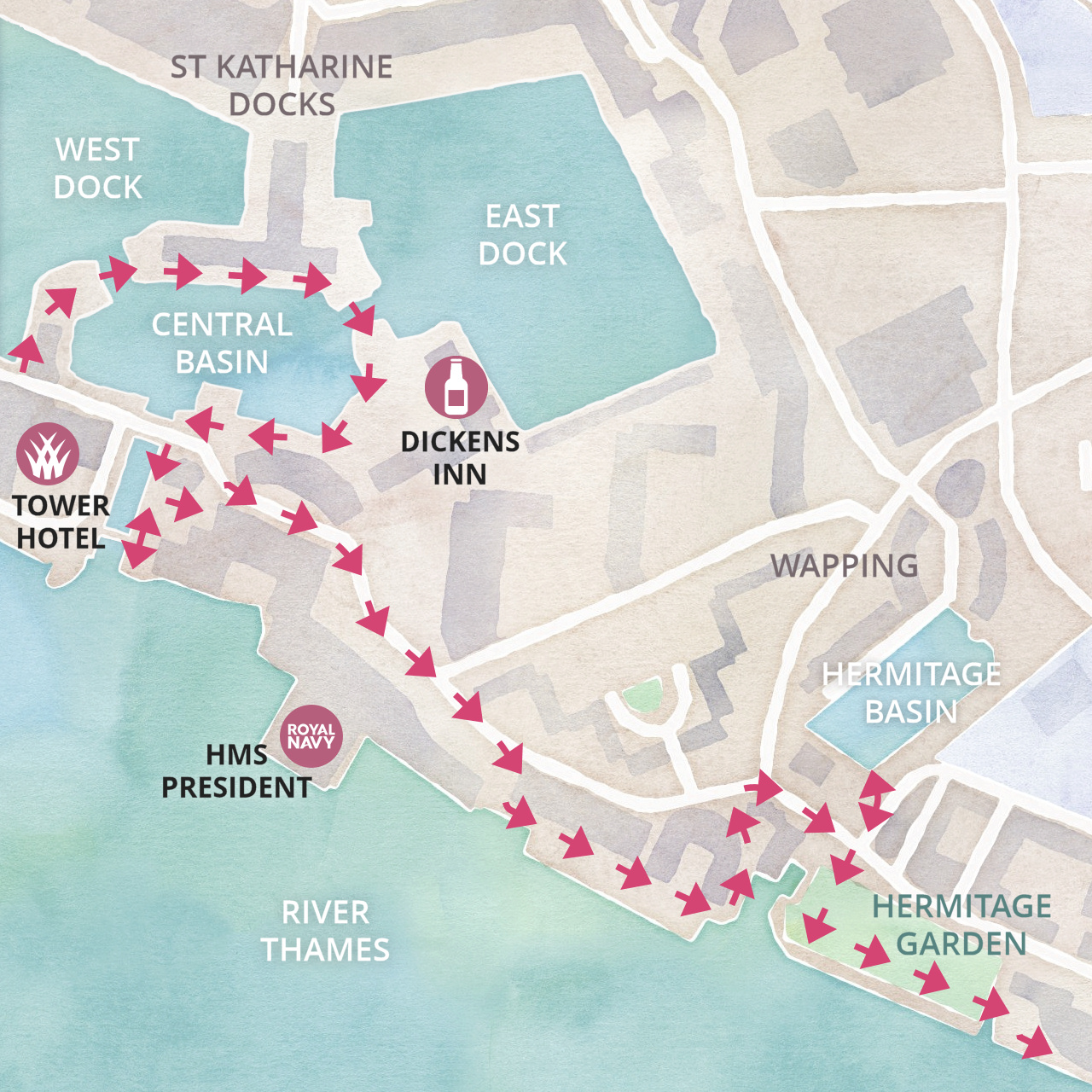
After the Coronarium, walk across the lift bridge and continue on past the row of cafes and restaurants. Half way along there’s a passageway that leads to public toilets and back to the Commodity Quay, the alternative route if the ‘pontoon pathway’ is closed.
Cross the footbridge over the entrance to the East Dock – notice on the left Thomas Telford’s original 1828 footbridge, whilst on your right the large anchor was salvaged from a Dutch ship called the ‘Amsterdam’, which sank off the coast of Hastings some 200 years ago.
Before you walk on, take a look back at the building you’ve just walked past. Called the Ivory House because this is where vast quantities of ivory were unloaded and stored, it’s the only original warehouse left in St Katharine Docks, most being badly damaged or destroyed in the Second World War. And quite amazingly, it still has its original rooftop clock.
Walk on now passing the Dickens Inn , a highly popular tourist destination that in summer is festooned with floral displays.
The Dickens Inn
However, the site it was on was earmarked for re-development so the entire 120-ton timber shell was ‘jacked up’ on wheels and moved 230 feet to its present position. It was then redesigned to look like a traditional three-storey 18th century inn, which is what we see today. Although named the Dickens Inn, the author would never have visited it; however, his great grandson was invited to the formal opening in 1976 and apparently said that Dickens “would have loved this inn.”
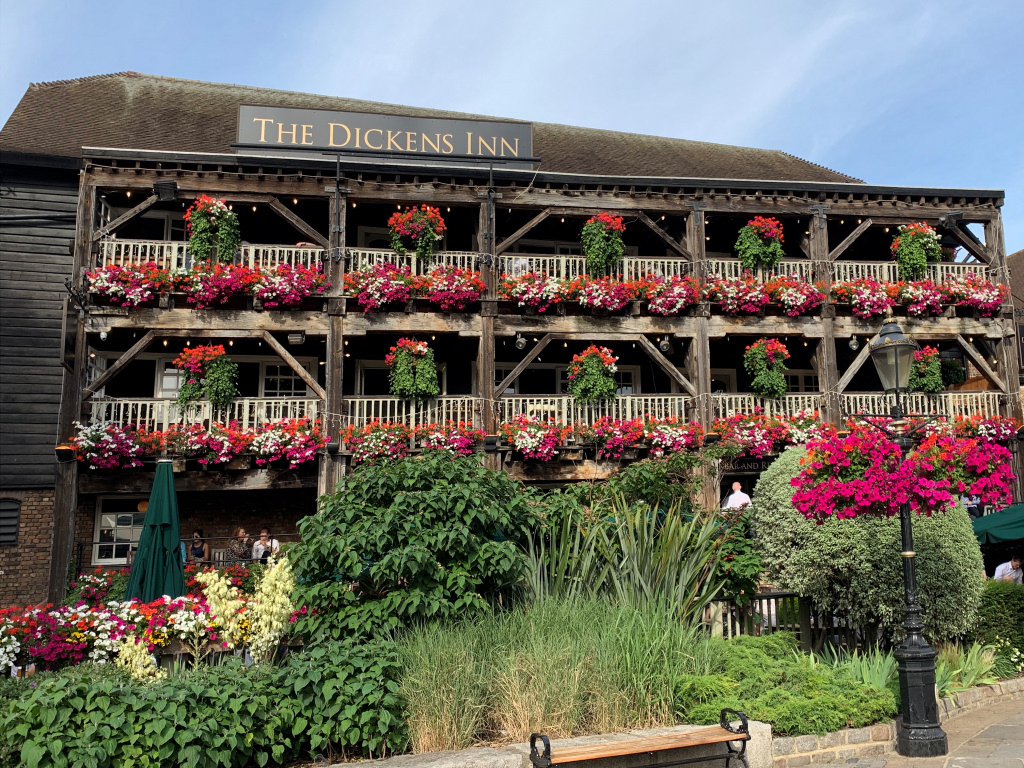
On your right you may see a ‘golden boat’ moored – this is the ‘Gloriana’, the Queen’s Row Barge which was built for her to sail down the Thames in as part of her Golden Jubilee Celebrations in 2012. It celebrates the Commonwealth by having the crests of sixteen Commonwealth countries along its sides.
Built in 1973, the Tower Hotel steps down from 15 storeys in each direction around what I have heard described as a ‘staggered cruciform’ plan, whatever that means. Whether or not it’s because of its 1970s design and (despite its stunning location) surprisingly small bedroom windows, it has now become more of a ‘package tour hotel’, rather than the prestigious establishment it once was.
After the large Indian restaurant is an unusual cream coloured ‘crescent-shaped’ three-storey building with pillars – we see the other side of it shortly and I’ll mention more about it then.
Continue alongside the basin to the end of the path and ahead is another view of the Tower Hotel. Walk towards the hotel , but don’t cross the bridge – instead turn left down to the right of the Dock Office and walk alongside the entrance lock that leads in from the Thames. You can see how narrow it is – as I’ve already explained this was partly responsible for the decline of these docks as the ever-increasing size of ships could no longer enter.
On the left of the lock is the old Dockmaster’s House, now a private residence. (And just in case this path is closed then use the road bridge to cross over the lock.)
The view from here is simply iconic, and for an even better look at Tower Bridge, cross over the bottom gate of the lock. Behind the bridge, on the other bank, you can see the unusually-shaped glass City Hall, the head offices of the Greater London Authority and base for its elected Mayor. Directly across the river from where you are standing is the enormous ‘Butlers Wharf’ building, once again previously warehouses but now very trendy apartments and with some excellent (and again expensive) restaurants on the river’s edge in front. But that’s the South Bank and another walk for another day.
Just to your left downstream is a Royal Naval base called HMS President (more on which shortly) and from its pier the Queen and Duke of Edinburgh ‘took the salute’ as the flotilla of ships passed by during her Golden Jubilee Thames Pageant.
Retrace your footsteps but halfway along the side of the lock walk up the steps alongside the Dockmaster’s House and at the end of the passageway turn right . On the other side of the road you can see the other side of the crescent-shaped building we saw just now. This unusual and perhaps classical-looking three-storey building is actually a row of private houses called Tower Walk. The architects took the inspiration for it from a terrace in extremely upmarket Regent’s Park and, although a nice building, I feel it is somewhat out of place here.
You are now in St Katharine’s Way . Turn right past Devon House , built on the site of a bomb-damaged warehouse in 1987 and recently refurbished, whilst next to it is the ‘shore-based’ HMS President , named after a First World War ship. (Naval land establishments like this are also known as ‘Stone Frigates’.) It is the largest Royal Naval Reserve unit in the country and provides a permanent Royal Naval presence in London, as well being the base of the Naval Regional Command Centre for Eastern England, the University of London Royal Naval Unit and the London Sea Cadets. It has its own quayside and jetty and was previously used as the London terminal of P&O’s jetfoil service.
Like many of the streets along the riverside, St Katharine’s Way was once lined with warehouses, but many were damaged or destroyed during the Second World War and subsequently rebuilt as offices or apartments. Unfortunately, as I mention again later in the walk, for many years town planners often appeared to turn a blind eye when it came to the rebuilding or renovation of many of these old warehouses, but an exception is certainly Millers Wharf that adjoins HMS President. Originally built in 1865 and restored in 1989, its frontage has been cleverly designed to look more like the warehouse it replaced.
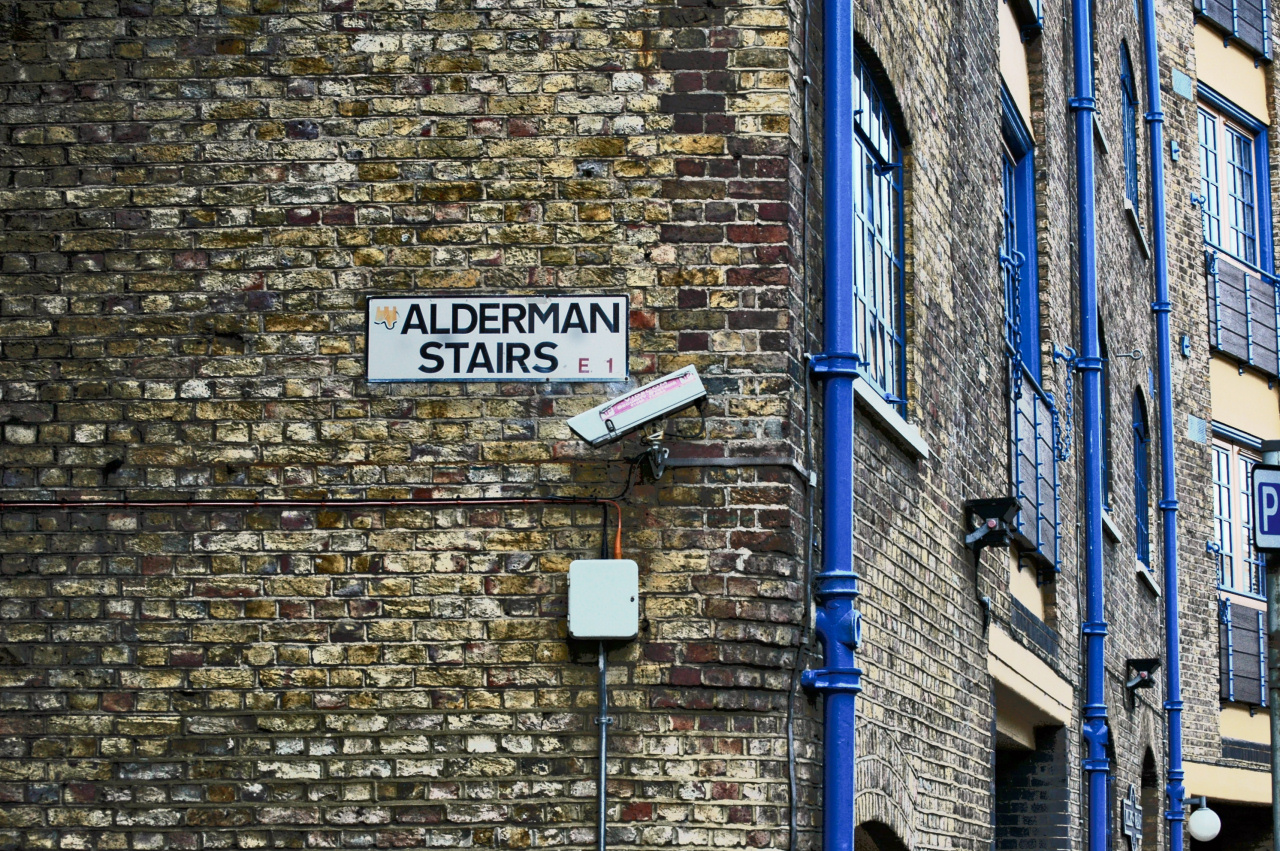
Between Millers Wharf and the adjacent building is a small passage, which as the sign says is Alderman Stairs .
Thames stairs
I’ve put an account in the appendix that was originally in the Illustrated London News on 23rd December 1843 and which I saw more recently on the excellent ‘London Inheritance’ website .
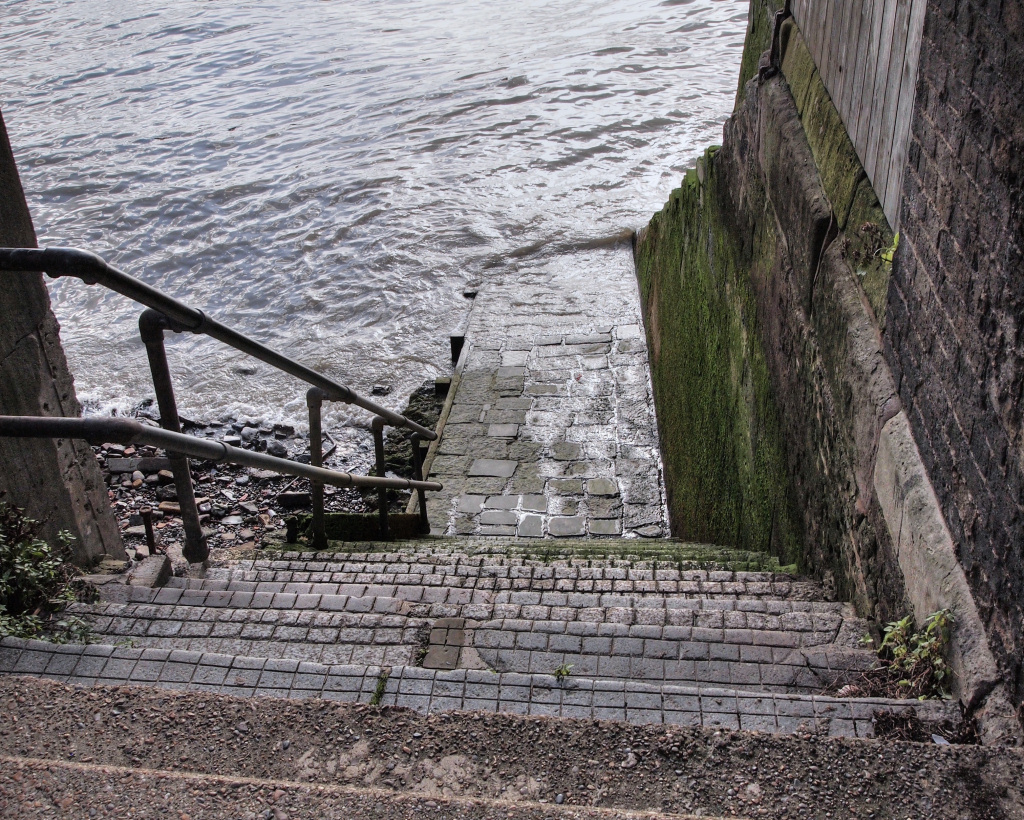
Next to Alderman Stairs turn immediately right between the buildings. It’s signposted ‘Thames Path’ and leads to a broad raised terrace (with steps up a little further down, so no need to climb the wall!) From here there is a wonderful view looking back up the Thames to Tower Bridge and across to the huge Butlers Wharf. As previously mentioned, these were once enormous warehouses but now trendy apartments. The small white building between the two Butler’s Wharf buildings was once a banana warehouse before becoming Sir Terence Conran’s Design Museum, which he opened in the late 1980s. The museum has now moved to Kensington. Just a little further to the left you will see the narrow outlet where the Neckinger River flows into the Thames; it was once the site of the small St Saviour’s Dock. The Neckinger is one of the Thames’ many tributaries – this one rises in nearby Southwark. Immediately beside and behind it was once one of London’s notorious slums, known as Jacob’s Island. It was immortalised in Charles Dickens’ book ‘Oliver Twist’ as the place where Bill Sykes, the principal villain, came to a horrible end in the mud of Folly Ditch.
The building behind you, now apartments called Tower Bridge Wharf, was once a six-storey warehouse that stored cargoes including wine and tea. On the quayside here fruit and vegetables were unloaded, to then be taken by road to the Covent Garden Market.
Walk to the end of the terrace and follow it around to the left – but first look over the wall and you can see where one of the original lock entrances used to be. (I explain more shortly.) On the other side the large Dove sculpture is in the Peace Park, which we see shortly.
The path brings you out at the end of St Katharine’s Way – and we turn right into Wapping High Street .

However, the road running straight ahead is Thomas More Street, which used to divide St Katharine Docks from London Docks. The street now leads up to a massive new 15-acre housing, retail and leisure complex called ‘London Dock’, not surprisingly built on the filled-in London Dock. It will have over 1,500 homes, shops, restaurants and even its own secondary school. It was on this reclaimed dock where in 1986 Murdoch built his controversial headquarters and print works for his newspapers – The Sun , News of the World , Times , etc. Nicknamed ‘Fortress Wapping’ because of how securely it was constructed – Murdoch knew that when he moved his newspaper operations out of Fleet Street there would be an almighty battle with the trade unions – and he was right of course. This was the scene of some of the ugliest battles in modern time between picketing strikers and those who chose to work. Those wanting to work were bussed in with police escorts and the bitter and violent demonstrations continued on a daily basis for many months. That was in the 1980s, and Murdoch has since moved the printing presses again, hence the new developments on the site.
As you turn right , you see the old single-storey brick building, which was once the hydraulic pumping and impounding station that kept the water levels in the docks at a constant level.
The road crosses a ‘bridge’ over the disused lock entrance we saw just now, which led into the Hermitage Basin , providing one of the two entrances into London’s Western Docks that was built in 1805 – we see the other one shortly. This entrance closed back in 1910.
Having crossed the bridge we’re going to make a short diversion – turn to the immediate left , between the original brick pillars that were once the entrance for the dock workers. Once inside you can appreciate the effort that has gone into preserving part of this basin. Walk to the top, where on the left you’ll see a fascinating ‘rope sculpture’.
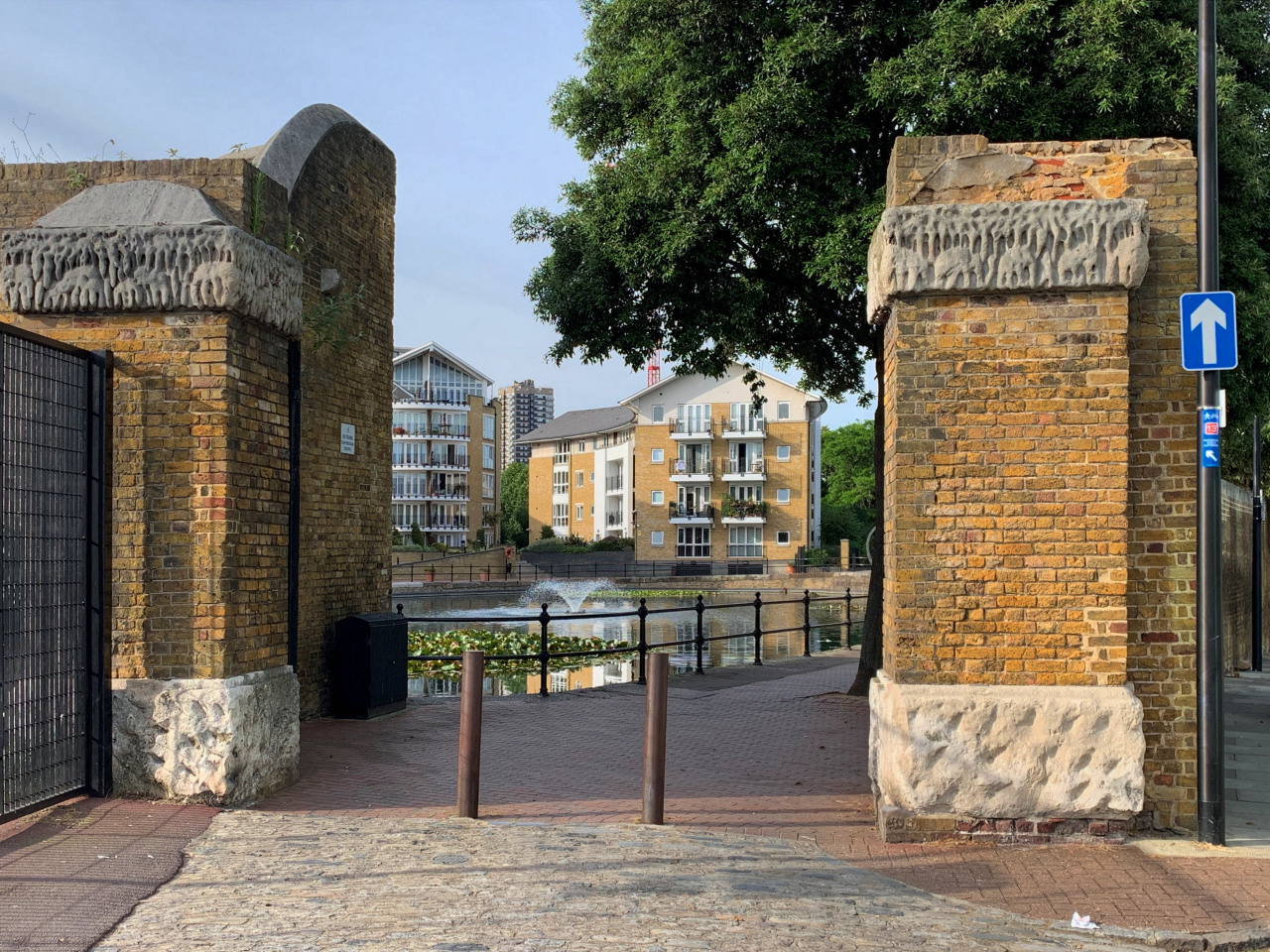
The end of the basin is a stepped terraced garden that leads down to what is now known as the ‘ornamental canal’ – cross over the road for a better look. Notice how much lower the canal is than the basin; this is because the basin was once 30 feet deep, but to make it safer it was partially filled in and the water is now less than two feet deep.
The original canal was once a broad waterway channel that allowed ships access through to Tobacco Docks and the Shadwell Basin that we see more of this later in the walk. I do think that the architects and planners have done an excellent job of redeveloping this part of the docks without completely losing any connection to what it once looked like. Even the modern housing developments on either side don’t look too out of keeping.
And the reason for the name ‘Hermitage’? Several hundred years ago there was actually a solitary dwelling (or hermitage) here.
You now need to turn around and head back to Wapping High Street and then cross over into the small riverside park.
This is the Hermitage Riverside Memorial Garden , built on the site of the Hermitage Wharf that was destroyed by massive firebombs on 29th December 1940. The park is a memorial to the terrible loss of life suffered by the people of London’s docklands and East End; they experienced the fiercest bombing of anywhere in Britain in the Second World War. Raids took place virtually every day for nine months in what was known as the Blitz. The Germans realised the importance of the docks to London – and of course to the rest of the country – so it became their number one target. (The word ‘Blitz’ comes from the German word Blitzkrieg , meaning ‘lightning war’ – the Germans believed that such intensive bombing on London’s docks and its East End would quickly bring about Britain’s surrender. However, they clearly underestimated the spirit of London’s East Enders as despite the Blitz lasting for nine long months – from September 1940 until May 1941 – there was never any thought of surrender. (And to put it into perspective, I have read that over 25,000 bombs exploded in this small area of London alone.)
The Dove sculpture was designed by Wendy Taylor CBE, the dove signifying hope and peace, whilst the empty space in the centre commemorates those who died.
The view up and down river from the garden is lovely. It is a great place to pause and imagine what life must have been like for people living and working here during that horrendous period. The garden itself is a testament to people power – developers wanted to build yet more apartment blocks, but the local people campaigned for years for a park to be built instead. What was eventually created was much smaller than they had wanted, but at least there is a garden.
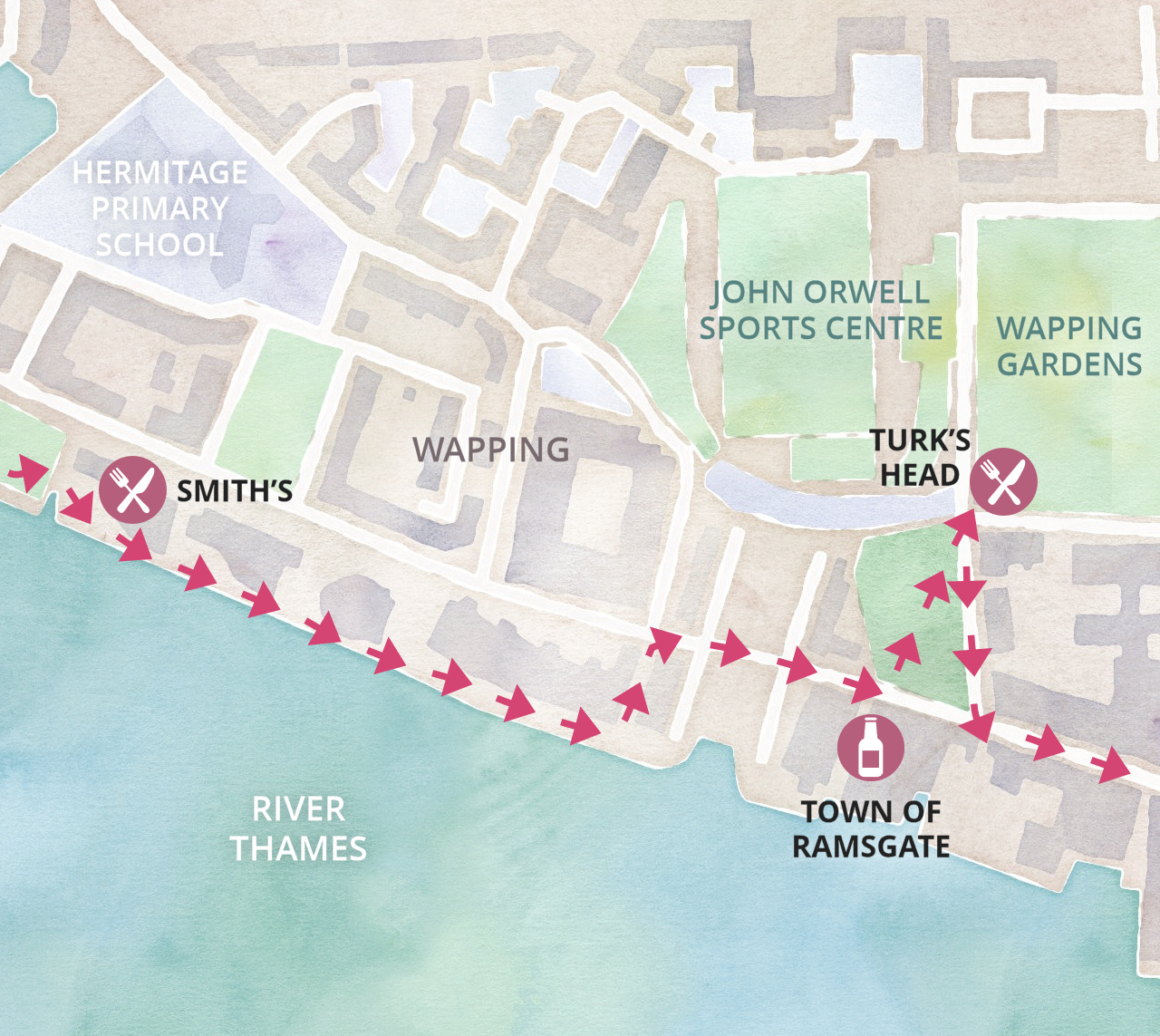
Walk through the garden alongside the river, passing the boats and sailing ships in the Hermitage Community Moorings. Keep on the riverside path as it continues along a broad promenade, passing the large Smith’s Fish Restaurant on the ground floor of the first apartment building. With its floor to ceiling windows it always looks an attractive place to eat, but whilst the menu looks excellent, I still haven’t tried it.
Three huge apartment blocks follow – West, Central and East Tower – fairly bland buildings but with interesting sloping roofs and balconies, which do appear to vaguely resemble those of a cruise liner – or am I being too optimistic?
At one time each section of the quayside’s wharves and warehouses specialised in specific cargoes and this stretch was predominantly spices. On the other side of the adjacent Wapping High Street many of the apartment buildings were built on the site of those spice warehouses and have been named after the islands where the spices came from – Sumatra Court, Java Court and Zanzibar Court, for example. And until only a few years ago you could sometimes still smell various spices in the air when you walked past.
The promenade now narrows and looks as though it comes to a dead-end, but it doesn’t, and it takes you back onto Wapping High Street . Where the passage turns to the left is another set of stairs – these are blocked off now, but were called the ‘Union Stairs’, and once gave access to the original Turk’s Head Inn, which as I explain later was where pirates and mutineers who had been condemned to be hanged at the nearby Execution Dock were allowed to stop for their ‘last quart of ale’.
Turn right back down Wapping High Street – which must surely be the only High Street in Britain without any shops. It did once have thirty-six pubs – but now there’s only three left. The street was built in the 1500s to link the riverside quays with the City of London and was described in the 16th century as a ‘filthy passage, with alleys of small tenements and cottages … whose many inhabitants were victuallers who supplied sailors with maritime equipment and just as importantly cheap alcohol and women’.
As I’ve already explained, the area was badly hit by bombing during the Second World War, and many of the warehouses were damaged, some beyond repair. The result was that for many years the area became a very neglected and forgotten part of London. However, in the 1970s and 80s developers began to restore and renovate the damaged warehouses and build on the derelict bombsites, resulting in the many new apartment buildings that are here today, which have made the area a very popular place to live, attracting an eclectic mix of new residents, from wealthy Canary Wharf bankers to celebrities such as TV chat show host Graham Norton.
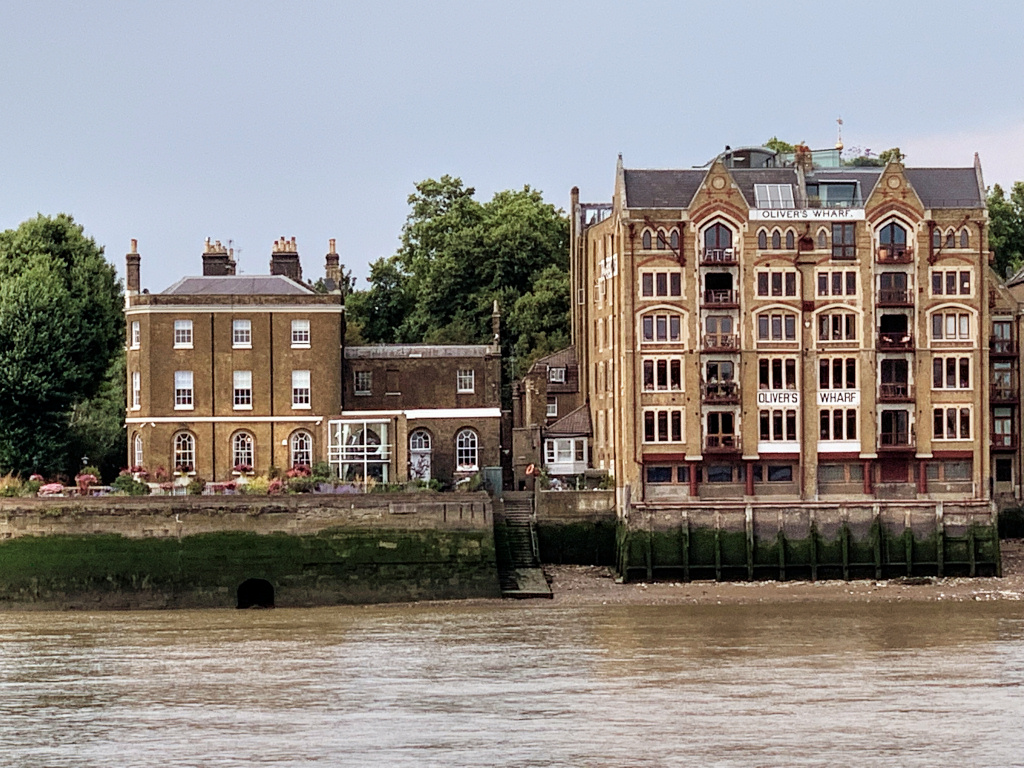
Pier Head, the Town of Ramsgate and Oliver’s Wharf
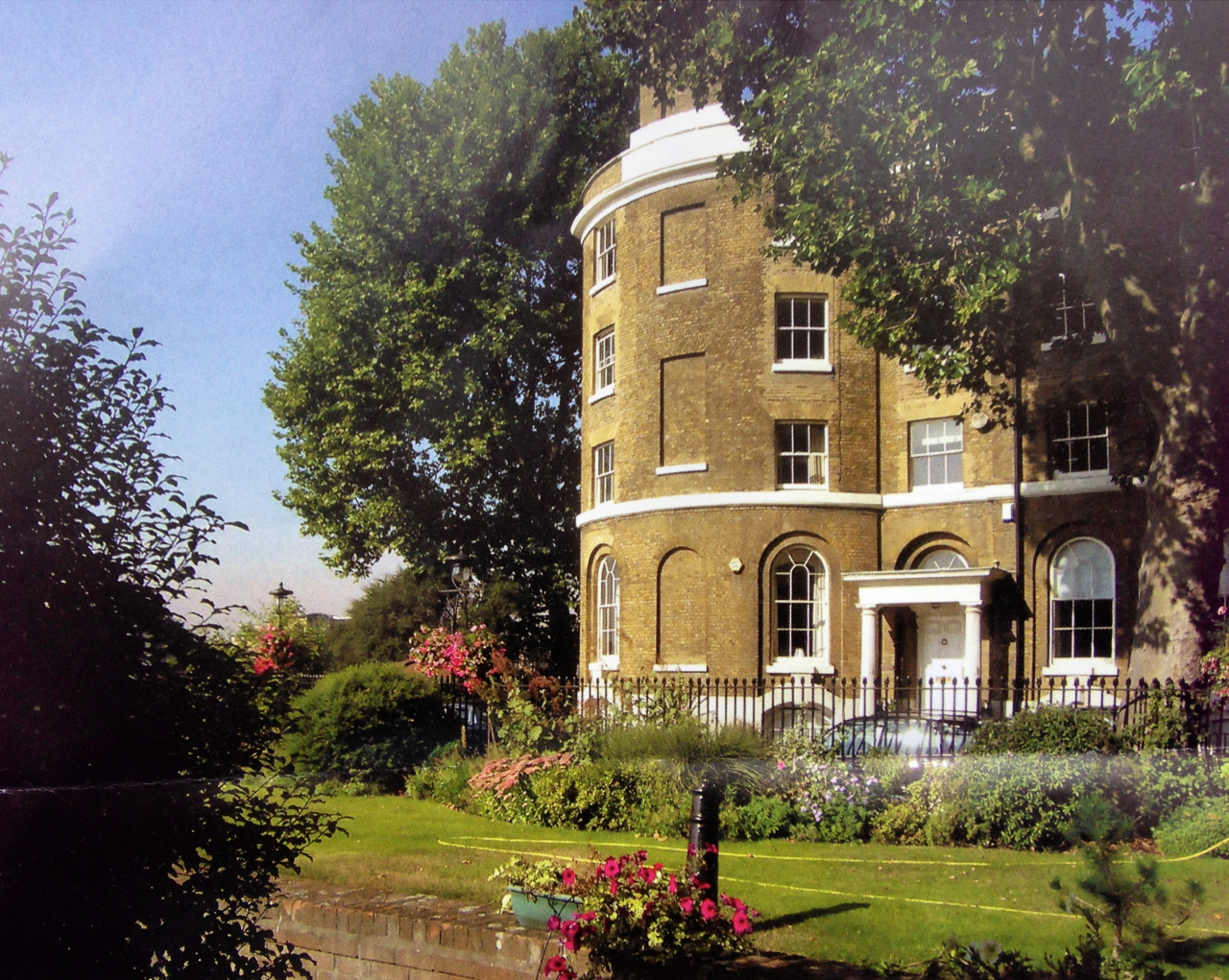
This next stretch is one of my favourite parts of the walk. Ahead you see what looks as though it might have been a bridge, which indeed it was. Known as the Wapping Pier Head , this was the second entrance lock through which ships entered the London Docks complex. Once again, the lock is now filled in and been turned into a delightful garden for the private use of the residents of the lovely Georgian terraced houses on either side.
These were designed in 1812 by D.A. Alexander, the surveyor and architect of the docks, as homes for the managers of the London Dock Company. Take a walk for a couple of yards up the paved access road in front of the terrace facing you (it’s marked to ‘Pier Head 4½–10’), which enables you to fully appreciate just how beautiful these old Grade II listed houses are. These were among the first riverside buildings in the area to be turned into luxurious homes and I recently saw an advert for a two-bedroom apartment in one of the houses for one and three-quarter million pounds!
Immediately after the Pier Head is the Town of Ramsgate , a very old inn that’s one of the few survivors of the 36 that were once along this street and which catered for the dockworkers and warehousemen as well, of course, as the sailors.
It’s definitely worth taking a look inside – (they are used to people popping in to do so) – and as you’ll see it’s small and narrow with lots of wood panelling that gives it an even more ‘historic’ feel. There’s a little terrace at the rear where you can enjoy views across the river.
Originally called the Red Cow (apparently after the distinctive hair colour of one of the early barmaids) the name was changed to the ‘Town of Ramsgate’, the name of a ship that used to sail here from Ramsgate in Kent to unload its cargo of fish, dairy produce and grain. It was always a popular inn for sailors – Captain Bligh and Fletcher Christian enjoyed a drink here before their last ever voyage. The pub’s cellars have had a gruesome history; convicted criminals were kept here before they were hanged, whilst a little later those same cellars were used to hold convicts before they were loaded on to ships for transportation to Australia.
But before or after you go inside the pub, take a look down the tiny alley next to it. These are the renowned Wapping Old Stairs . If the tide is out, then you can walk down to the pebble beach beneath the pub – but be careful – the steps are deceptively slippery and can be treacherous thanks to a mixture of slimy mud and algae. If you do gingerly make your way down, then notice the noose hanging from the rear of the pub.
Another notable event in the long life of the pub was the capture here of the infamous ‘Hanging’ Judge Jeffreys, much hated due to his habit of giving extremely harsh sentences to those he tried in court. He was said to have been responsible for the hanging of many men here. He had also presided over the courts in a number of towns in south-west England during the ‘Monmouth Rebellion’, when loyal Protestants tried to overthrow the Catholic King James II. (It was called the Monmouth Rebellion because it was led by the Duke of Monmouth, an illegitimate son of Charles II.) Jeffreys sentenced hundreds of men to death and many others were sentenced to transportation.
However, he had his comeuppance here when he was caught trying to escape retribution following the 1688 ‘Glorious Revolution’ when James II himself was overthrown. Unfortunately for him, Judge Jeffreys had ‘backed the wrong side’ and was attempting to board a collier en route for Germany in an attempt to escape from his own death sentence when, arrogantly and stupidly, he went into the pub for one last glass of ale. Despite being in disguise he was soon recognised, captured and taken to the dungeons of the Tower of London.
There is an excellent account of Jeffreys’ capture in the Walter Thornbury’s fascinating book ‘Old and New London’, which was published in 1897 and I have put it in the appendix .
Someone else captured here whilst trying to escape by ship was Thomas ‘Captain’ Blood, the Irishman who in May 1671 was found in possession of the Crown Jewels he had stolen earlier from the Tower.
Time to stop for a snack? The Turk’s Head may still look like a pub but it’s now an excellent café and a great place to stop for a coffee, sandwich or even a more substantial lunch.
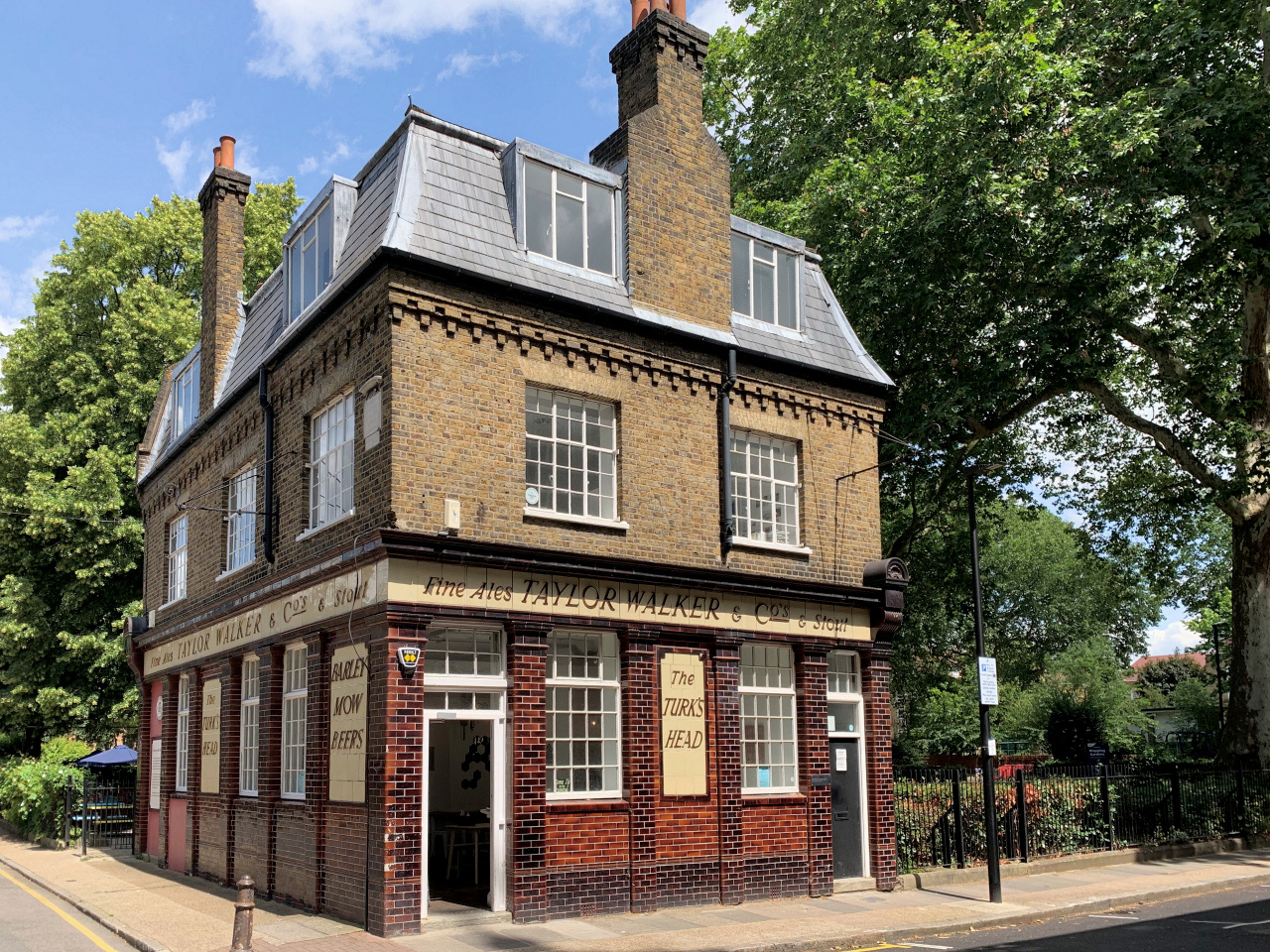
Immediately opposite the pub is a gate leading into a small garden cemetery that once belonged to St John’s Church in the adjacent Scandrett Street. Walk through it across into Scandrett Street and just to the left you’ll see the Turk’s Head .
The Turk’s Head
During the Second World War the landlady was ‘Mog Murphy’, and she kept the pub open all hours of the day and night for those returning on leave from fighting in the war and who were trying to find information about families and friends who lived in the area.
The pub closed in the late 1950s, but a few years later a group known as the ‘Wild Women of Wapping’ set up a charity called the Turk’s Head Company and set up a campaign to persuade the council to allow them to buy what was then a derelict building and restore it as an amenity for local people. These days the income from rent of the café and the studios above pay for the women’s charitable activities.
The café is still a community affair and serves very good and very reasonably priced food. There is a little garden outside where you can enjoy your coffee or lunch.
Finally and some years later, the ‘Wild Women’ were heavily involved in the protests against the proposed East-West Expressway that would have been built through the middle of Wapping, destroying much of the locality, including the Turk’s Head. We have them to thank for the successful outcome of their protests, otherwise we wouldn’t be doing this walk today!
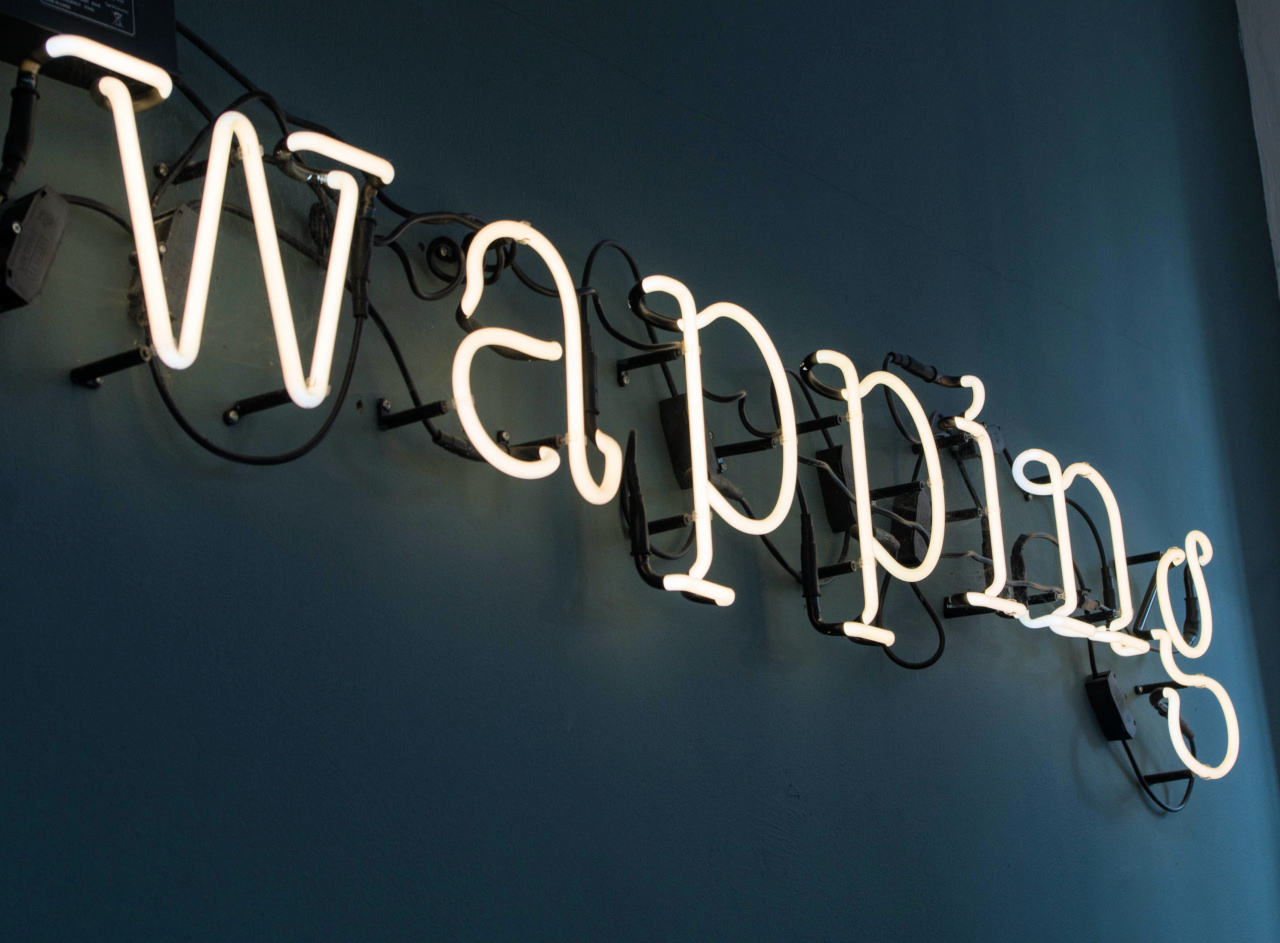
Leave the Turk’s Head and start walking back up towards Wapping High Street, passing the St John the Baptist Church . Now no longer a church and converted into apartments, it was built in 1617 as a ‘chapel of ease’ to St Mary’s Whitechapel. (A chapel of ease is a building that’s not actually a church, but where people can worship, and which is under the jurisdiction of a parish church). However, in 1694 Wapping became a separate Parish and therefore required its own Parish Church so in 1756 St John’s was rebuilt and enlarged. It was badly damaged in the Second World War, with only its tower and the shell of the church left standing and was never rebuilt. Interestingly, the tower was built of an unusual combination of coloured stone and brick, carefully chosen to be visible by ships sailing up the Thames in foggy weather to aid their navigation. It was clearly well-enough constructed to have survived the bombing that destroyed the rest of the church.
Next to it is an 18th century charity school building that has also been converted into apartments. Founded in 1704 for fifty boys and forty girls, there are two lovely Coade stone statues, one of a boy and one of a girl, both in colourful uniforms, above the entrance – and in case there’s any doubt as to which should be used, the words ‘Boys’ or ‘Girls’ are carved above. The adjacent building has the words ‘infants’ above one door and ‘boys’ above the other, so presumably it was built before education for girls was properly accepted.
Walk back up to Wapping High Street and turn left. On the other side of the road at Number 64 is Oliver’s, a former tea store and one of the first warehouses to be converted into luxury apartments. (American singer Cher was an early resident.) The building next door was built for social housing, something much needed within the area, but I can’t help wondering whether more thought have gone into its design and construction to make it a little more attractive and in keeping.
Pierhead Wharf was built in 1996–7 in place of a Victorian warehouse and in the style of the surrounding survivors. An extra floor with four penthouses was added in 2003.
The St John’s Wharves warehouses on either side of the street have been well preserved, and a notable feature are the overhead gangways that once enabled porters to transport goods from one warehouse to the other.
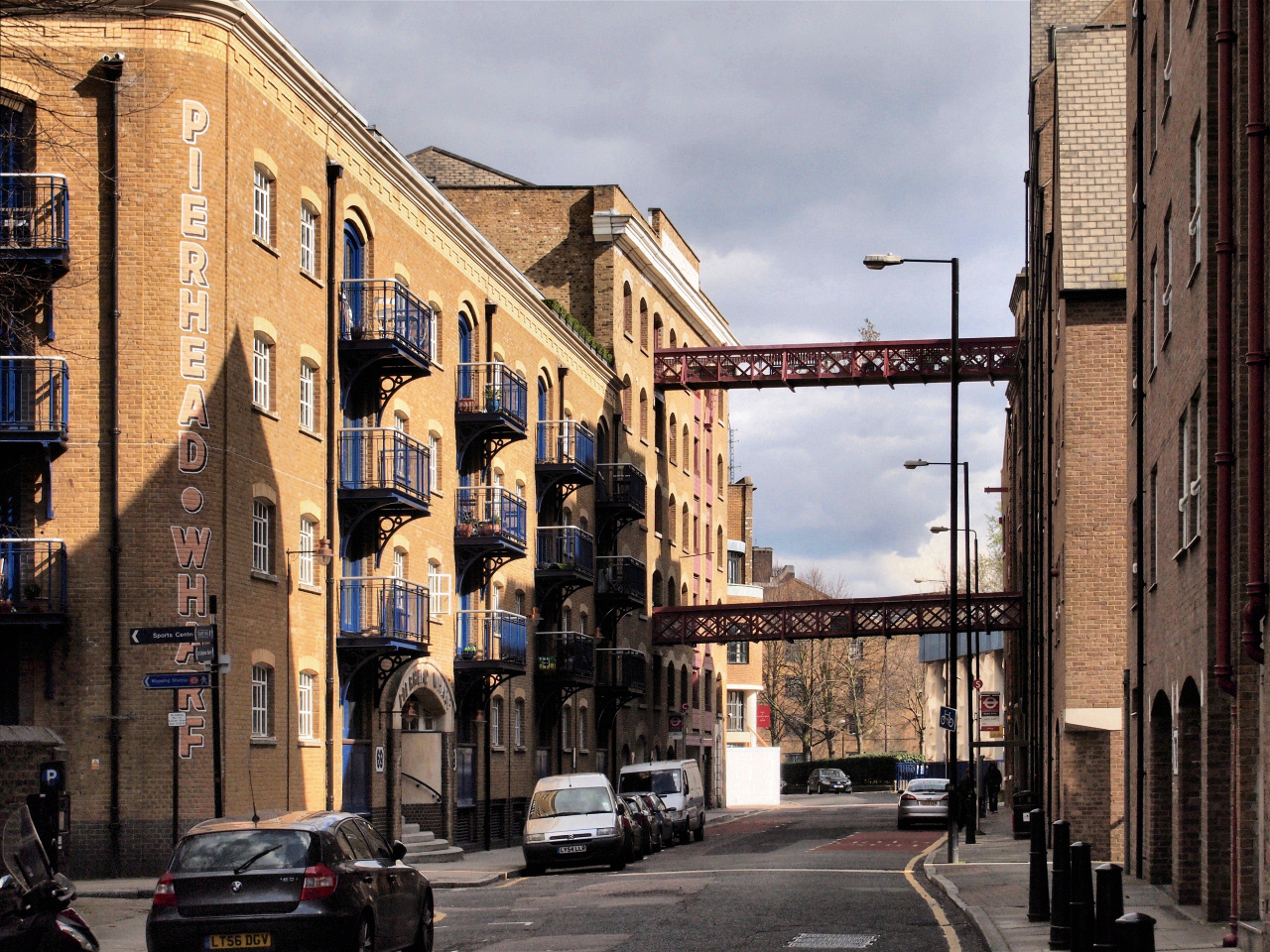
Then comes a most unusual 1970s building with weird fibreglass shapes that I’ve heard some call a ‘monstrosity’, whilst others ‘a wonderfully creative abstract concrete building’ – but I have to say to my mind it’s just ugly and totally out of place. (Having said that, the estate agent’s office opposite could easily win an award for inappropriate design in an historic street.) Somewhat surprisingly, it is the maintenance yard of the Metropolitan River Police , where their patrol boats are repaired and stored. The actual river police station is just a few hundred yards further on.
Turn right into the Waterside Gardens. This was the site of the notorious Execution Dock that I mentioned earlier, where for more than four hundred years pirates, smugglers and mutineers who had been sentenced by Admiralty Courts were hanged. (The Admiralty Court was responsible for trying and convicting those who had committed offences at sea and had been bought back to London to face justice.) The ‘dock’ consisted of a scaffold – and in order for the condemned man to suffer as much as possible there was no ‘trapdoor’, so death was often by slow strangulation. It was then the custom for the bodies to be left hanging here until three tides had washed over them, making them clearly visible for all to see, so as to act as a deterrent to other potential pirates or smugglers. Not that it seemed to have much effect though!
‘Hanging events’ were a great attraction for locals – the condemned man would arrive in a cart, accompanied by senior officers from the Admiralty. Custom had it that he would be allowed to stop for a last quart of ale and, as already mentioned, that often took place at the Turk’s Head Inn just a few hundred yards up river.
The last execution was said to have taken place here in 1830, but one of the most infamous of all pirates to be hanged here was Captain Kidd, which took place in 1701, and his name lives on in the pub that we come to shortly. (Captain Kidd was said to have provided the inspiration for Robert Louis Stevenson’s adventure novel Treasure Island .)
Alongside the Gardens are the Wapping New Stairs, but it’s not advisable to attempt to go down, as the steps suddenly end in a vertical metal ladder!
From the Waterside Gardens you can look downstream and see the pier used by the River Police – and if you look carefully you can see the blue lamp still hanging nearly half way along – at one time these were hung outside all police stations. Next to the pier is the actual Metropolitan River Police station . Now called the Marine Policing Unit, it was built in 1909 on the site of the very original station. The station is now closed to the public, but if you walk up the little passage to the right you can see another original blue lamp still over the door.
To the right on the opposite bank of the river you can see a little group of trees in a short stretch ‘green area’ known as Cherry Gardens. For several hundred years this was a popular place to take a stroll and admire the river views and, in his diary, Samuel Pepys recorded visiting the gardens to buy cherries for his wife. And it was from here that J.M.W. Turner got the inspiration for one of his most popular paintings – The Fighting Temeraire , (the famous ship that took part in the Battle of Trafalgar) being towed by steam tug to the breakers yard in Rotherhithe. Nowadays the Cherry Garden Pier is the base for the City Cruise pleasure boats. Just to the left of it is the historic Angel pub, and to the left of that the old ‘leaning’ building was once the base of the last company of lightermen to operate on the Thames. To the left of that was once Edward III’s manor house, whilst further to the left you can see the spire of St Mary’s Church, Rotherhithe.
Thames River Police
The situation eventually become so bad that three men took on the job of persuading the West India Company to set up a private ‘police force’, said to be the first organised police force in Britain and probably the world. I have written more about it in the appendix .
Within the police station there is a small museum dedicated to the history of the River Police. It’s run by two former officers and open only by prior arrangement. There is a collection of memorabilia, artefacts, photographs, etc. going right back to the very earliest days of the River Police. It took me a while to arrange an appointment to visit, but it was certainly fascinating and very enjoyable.
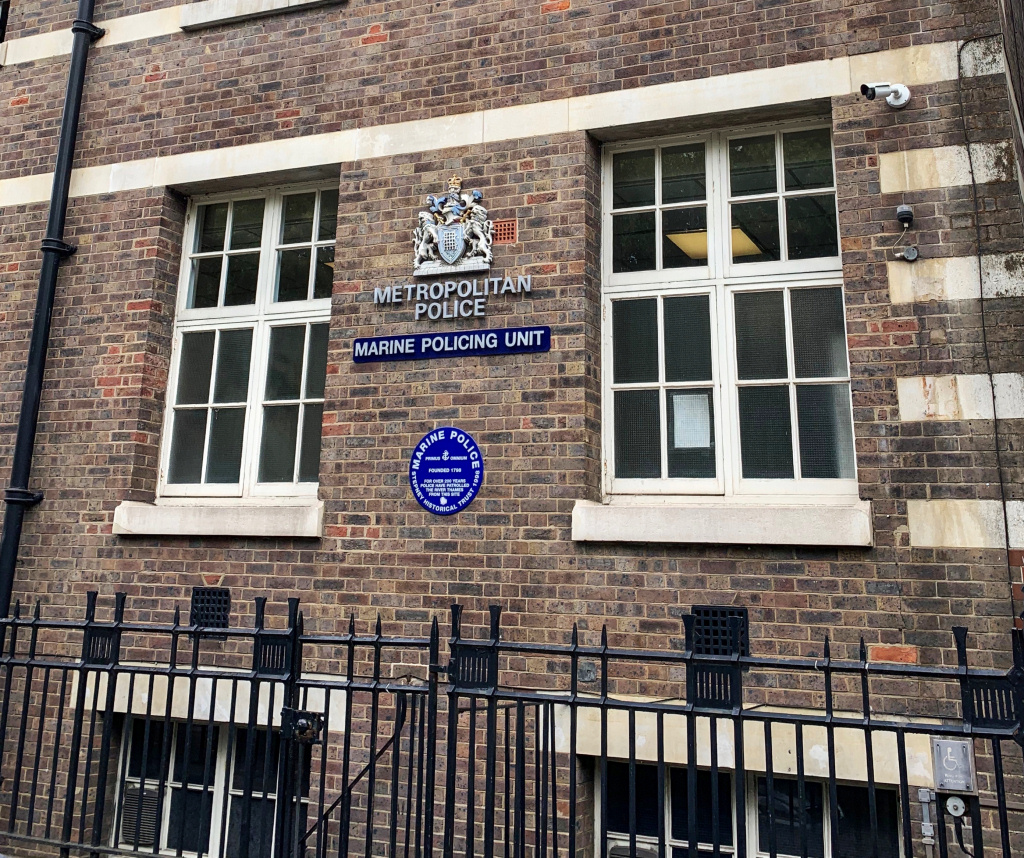
Next to the police station are the Aberdeen and St John’s Wharfs, two more well-restored buildings with plenty of authentic (looking!) features, whilst on the other side of the road is another park, the Wapping Rose Garden.
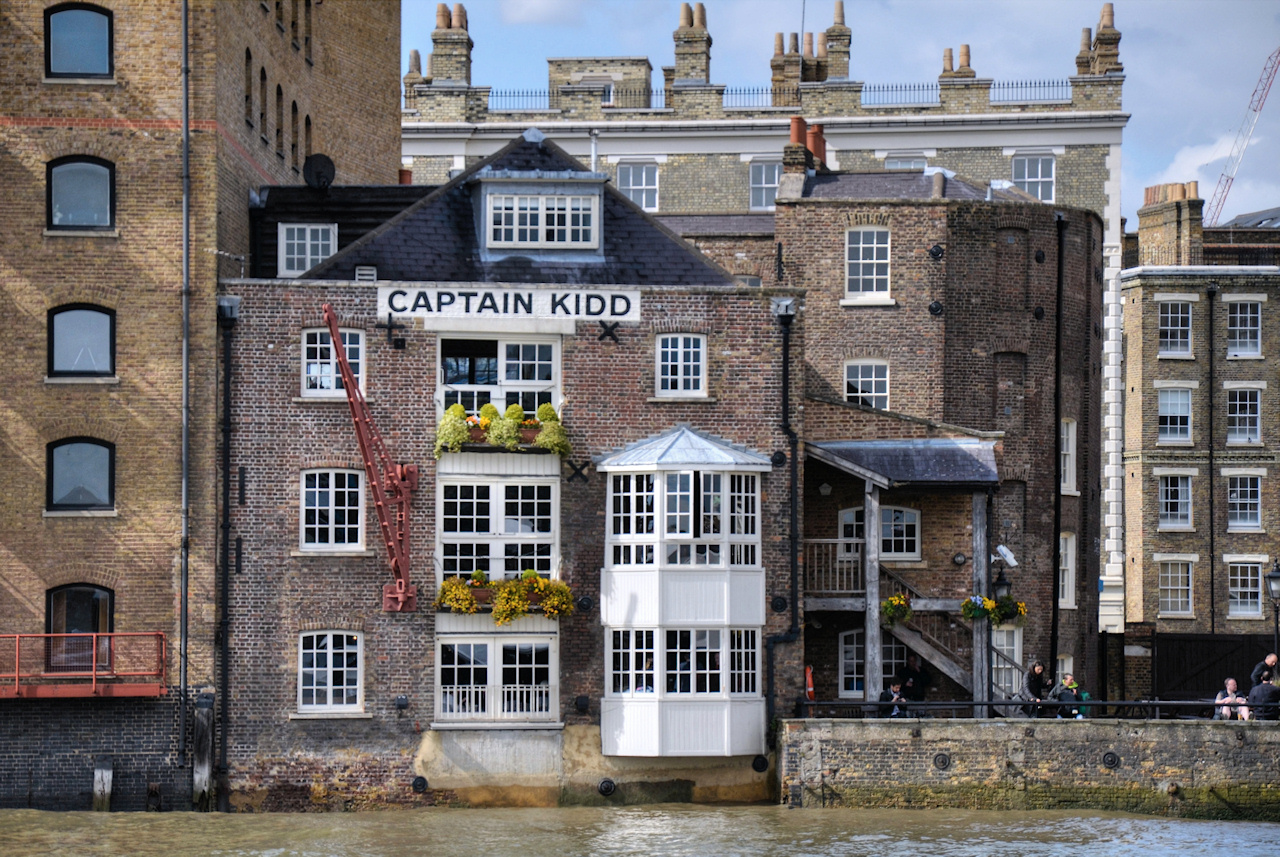
The Captain Kidd pub may look very ‘olde worlde’, but it certainly isn’t. It’s named after the infamous Scottish privateer, William Kidd, a onetime naval officer who after being sent to catch pirates turned to piracy himself. As I mentioned before, he was hanged at Execution Dock in 1701 having been convicted of piracy and murder.
Whilst the actual building dates back to the 18th century, it was originally a warehouse that stored coffee, dried fruits and bales of wool from Australia, and was only converted into a pub in the 1980s. It is a fascinating place all the same. I love the narrow courtyard entrance – notice the noose hanging over the entrance door – and besides the spacious bar on the ground floor there is also the Galleons Reach restaurant upstairs. Best of all though is its terrace that overlooks the river, arguably the biggest along this stretch of the Thames. So even if you don’t fancy having a drink it is worth a quick visit. Looking from the terrace of the Captain Kidd to the other side of the river, you can see the sign saying ‘Thames Tunnel Mill’ on a former 19th century flour mill that until the 1970s was producing flaked rice and tapioca (which brings back horrid memories of the puddings served for school dinners).
Behind it is the historic Church of St Mary’s in Rotherhithe, famous for its connections with the Pilgrims’ ‘Mayflower’ sailing to America.
Continuing on, next to the Captain Kidd is Phoenix Wharf , one of the few warehouses that actually appears to be original and not modernised, and still with the ‘hauling’ doors on each level where goods would be hoisted up on pulleys for storage. Rather unusually, not many of the buildings on this short stretch appear to have been so badly damaged or destroyed in the war – photographs taken pre-1940 show very little difference to the structures you see today.
Alongside it are the King Henry Stairs and a narrow walkway leading to ‘Wapping Pier’. The gate leading to it is locked and is the base of the Silver Fleet Thames Cruisers.
Almost opposite is the architecturally interesting New Tower Building . Built in 1886 by the Improved Industrial Dwellings Company, it’s adjacent to a small piece of land that for some reason until now hasn’t been built on, although it seems that’s about to change as planning permission has been granted for the site to be developed, so building work may be underway when you visit.
There are two places where the walk can be finished – this is the first, so if you’re out of time (or energy) then you can end your walk here .
To do so, simply carry on walking down Wapping High Street for five minutes , passing the enormous restored King Henry’s Wharves and Gun Wharves. These were so named because this was where Henry VIII built a foundry to make cannons for his navy. Although now converted into luxury apartments, once again the exterior of these huge warehouses appear to have retained their original facades.
Continue on, passing Wapping Lane on your left and after a couple of hundred yards you’ll see Wapping station on your right.
GETTING BACK TO CENTRAL LONDON
Wapping station is on the London Overground network (although it is underground at this point).
- To connect with the DLR service to Bank and Tower Gateway take the train from Platform 1 for one stop north to Shadwell, or
- To connect with the underground network then continue on one more stop to Whitechapel and change onto either the District or Hammersmith & City Line.
Trains from here will take you to many parts of central London.
Bus Route 100 will take you from Wapping station back into London. Stops include St Katharine Docks, Tower Gateway station, Bishopsgate, Moorgate station, London Wall/Museum of London, St Paul’s station.
Alternatively, the walk continues a little further (approx. 45 minutes) and visits other parts of Wapping and several particularly interesting features, including Tobacco Dock and the Shadwell Basin. However, it also ends back at Wapping station.
If you wish to carry on, then we’re going to turn left up Brewhouse Lane along the side of the New Tower Building. But before you do, first look ahead down Wapping High Street and you’ll see the enormous King Henry’s Wharves and Gun Wharves, so named because this was where Henry VIII built a foundry to make cannons for his navy. Although now converted into luxury apartments, once again the exterior of these huge warehouses to have retained their original facades.
(Should Brewhouse Lane be closed as a result of the building works, simply continue on down Wapping High Street for a few hundred yards and turn left up Wapping Lane.)
However, if you are able to walk up Brewhouse Lane, then on the left at the top is Tower Building, another block of flats built by the Improved Industrial Dwellings Company.
The company was formed in 1863 by Sir Sidney Waterlow. He was a printer and philanthropist, who later became a Lord Mayor of London. The company was a ‘model dwelling company’ – one of a group of private companies set up to improve the housing conditions of the working class by building homes specifically for them. They were not charities and had to ensure that investments in them received a competitive rate of interest. The homes they built were of a higher standard than would normally be built for working men and women, with better sanitation and less overcrowding. The Improved Industrial Dwellings Company was one of the largest and most successful of such enterprises and by 1900 housed 30,000 people.
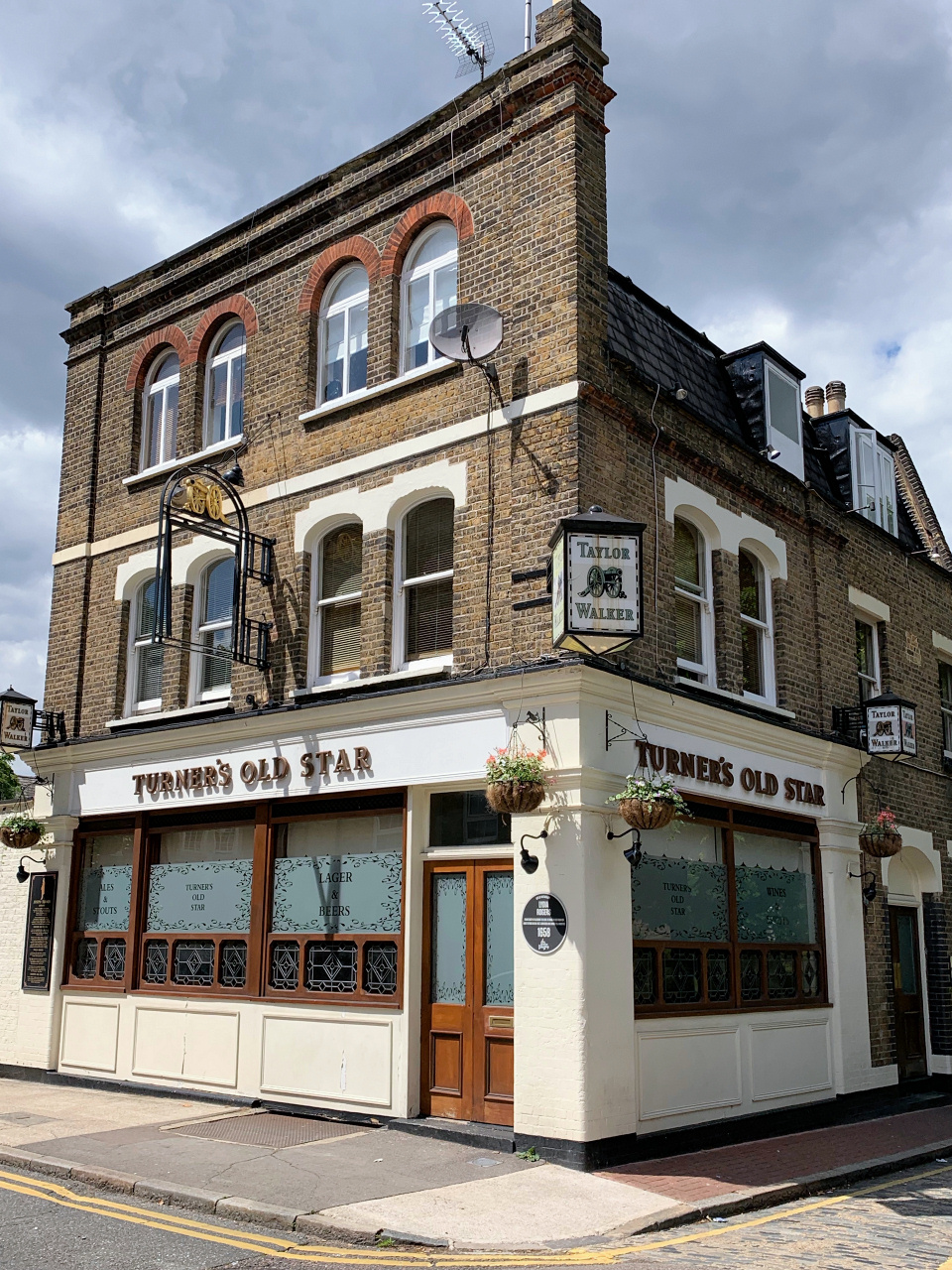
At the end of the road turn left into Wapping Lane , a street that’s at the heart of the Wapping community and still has shops such as a traditional butcher (a rare sight these days), a fishmonger, greengrocer, general grocery store, newsagent, pub – and even a Pizza Express restaurant.
Cross Green Bank then take the next left into Watts Street , alongside the little triangle of ‘green’. Notice on the left the carefully renovated blocks of flats (I love the large windows) built originally by an early housing association in co-operation with the local authority.
Directly ahead, on the corner of Meeting House Alley , is the Turner’s Old Star public house, (with the rather unusual view of the Shard beyond, which to me seems strangely out of place here.)
The artist J.M.W. Turner converted two cottages that he had inherited in 1830 into a tavern to be run by Sophia Booth, a widowed landlady from Margate, who was one of his mistresses. He spent much of his time here, particularly as he was fascinated by the River Thames, the source of many of his paintings. However, he tried to keep it a secret, no doubt partly because he was said to have had several other mistresses at the time, so rather than use his own name when he stayed here, he used a pseudonym of Sophia Booth’s name. As a result of his short height and ‘portly physique’ he was soon simply nicknamed ‘Puggy’. Amazingly, the pub is still going strong today, having been renovated in the 1980s.
Walk up Meeting House Alley , which that runs up the right-hand side of the pub, then turn right into Chandler Street and then turn left back into Wapping Lane .
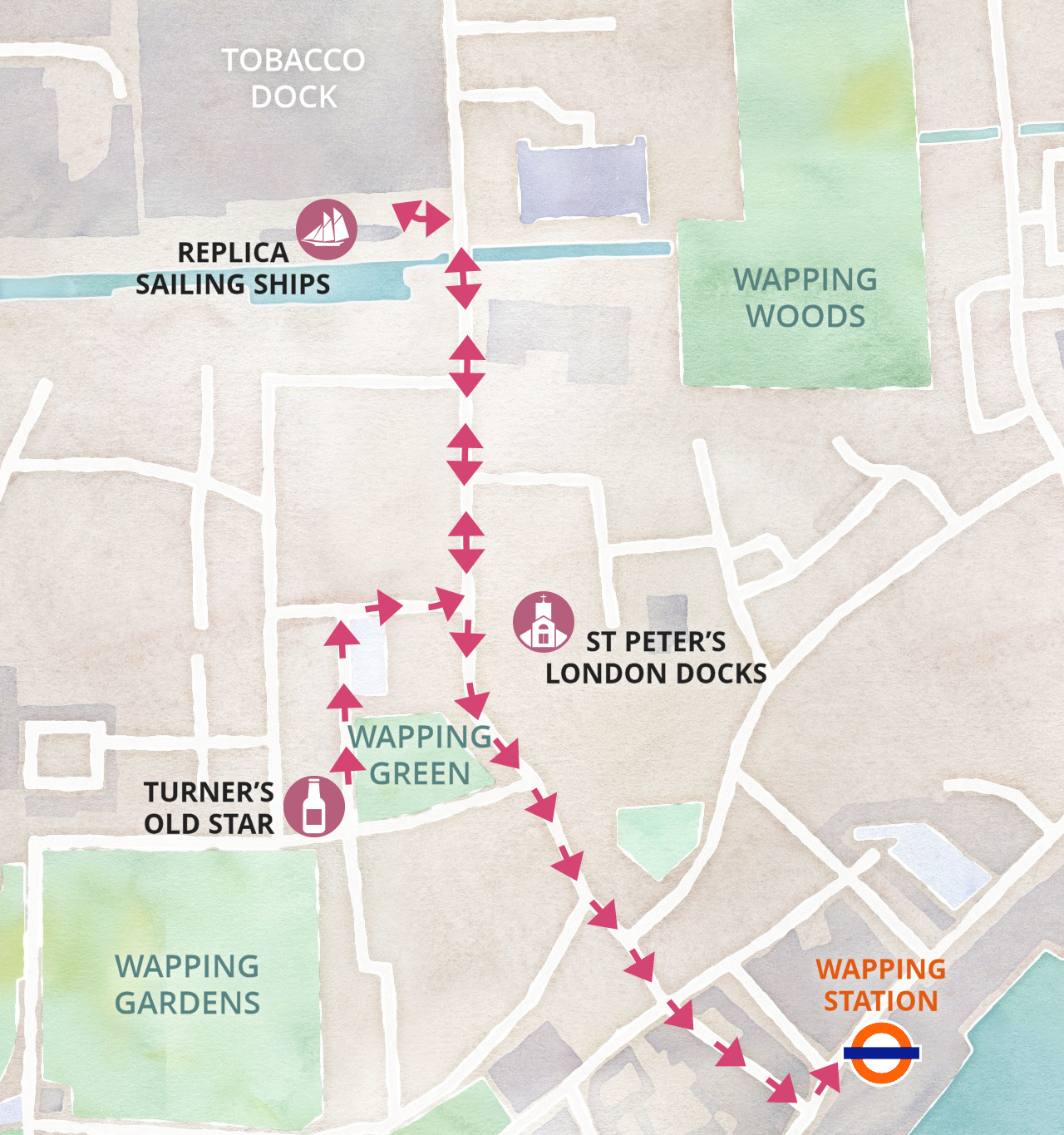
On the other side of the road is St Peter’s , the parish church of Wapping. The entrance is not obvious – it’s through an unusual arched entrance into a tiny courtyard. If the church is open, (it is most days) then it is worth going in to take a look. Whilst it might appear to be a Catholic church, it is actually Church of England, although run by the Society of Holy Cross, an Anglo-Catholic International Society.
St Peter’s London Docks
Wapping was one of the poorest districts in London, a haunt of prostitutes and petty criminals, living alongside those who earned a precarious living from the docks.
Lowder’s group of Clergy and Sisters provided practical care through Schools, clubs, cheap canteens and child care and spiritual care through a wide range of services, centred on the Mass at the Mission Churches.
In 1866 the new Church of St Peter in Old Gravel Lane (the church we visit) was consecrated. Soon afterwards cholera struck the East End, Lowder organised the Sisters of Mercy and others to care for the sick and raised funds for a tented hospital. The Priests and Sisters took great risks and worked without stint for the people of Wapping. At the end of the cholera outbreak, people were calling Lowder, ‘the Father’ because he seemed like the father of the whole community. This soon became ‘Father Lowder’, the first known example of an Anglican priest being thus addressed.
In 1873 Lincoln Stanhope Wainwright came to Wapping as curate to Father Lowder. He was to remain over 50 years in the service of the people here. Father Wainwright was a living saint, never ceasing in his work, giving away the very clothes and shoes he wore. He once discovered a young lad stealing a clock from the Clergy House, persuaded him to have some cocoa in the kitchen, talked to him at length and soon had him serving Mass in the Church and in employment.
Father Wainwright died in February 1929 in St Peter’s Clergy House. The people of Wapping stood in line to climb the uncarpeted stairs to view the mortal remains of one who had been their priest and friend for a lifetime.
St Peter’s London Docks has had other great priests: Father Pond who put the parish back on its feet after Father Wainwright’s long final illness, Father Leutchford who was loved for visiting round the parish from shelter to shelter during the blitz, Father Fox who moved mountains in the post war years to repair the Church, Father Foizey who served Wapping for over twenty years in difficult times of change and Father Peel who transformed the old parish school into a social centre. Wapping has had great priests because priests have always counted it a privilege to serve this unique community.
(From St Peter’s website )
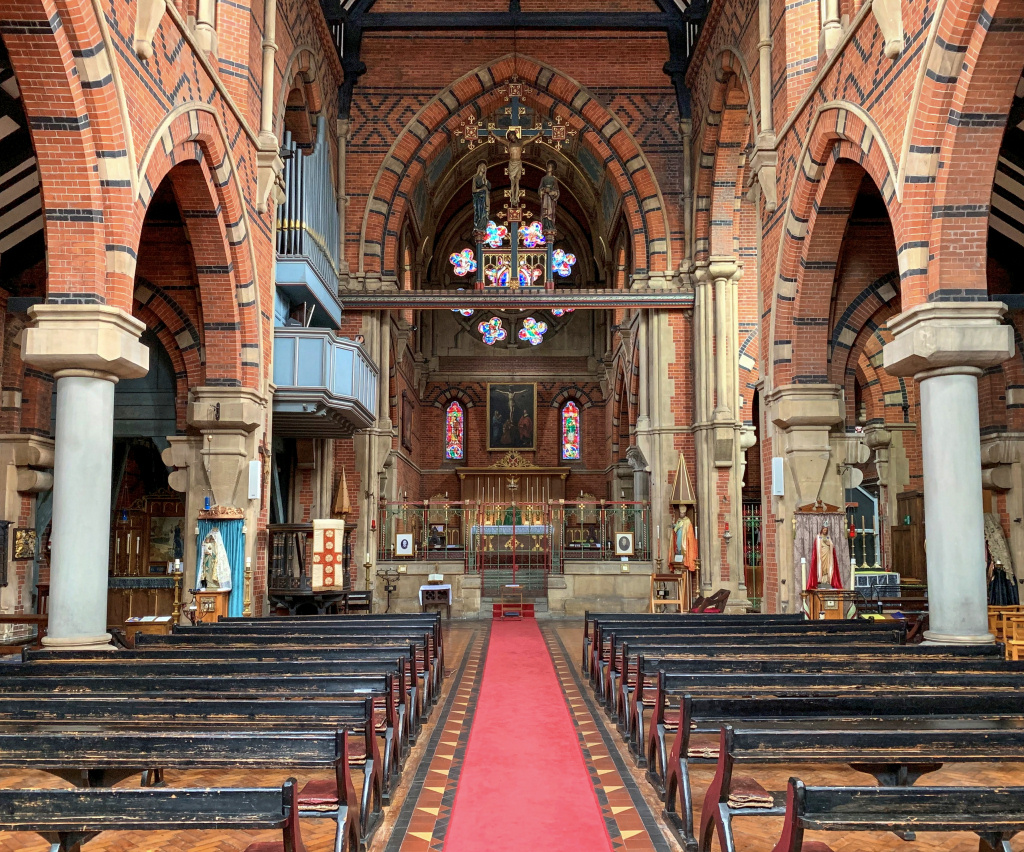
Continue on up Wapping Lane for several minutes until you reach the bridge that crosses the Ornamental Canal – the same one you saw back in Hermitage Basin – and directly in front of you is the imposing brick-built Tobacco Dock .
In a dry dock between the ‘canal’ and Tobacco Dock are two sailing ships that are replicas named and designed after real ships. One was the 330-ton Three Sisters, which was built in the dockland’s Blackwall Yard in 1788 and used to sail to the East and West Indies to bring back tobacco and spices. The other was the Sea Lark, an American merchant schooner that was captured by the British navy in 1811. They were installed as part of the plan to create a major shopping and leisure complex here, which I explain shortly.
Tobacco Dock was designed by the London Docks’ architect Daniel Alexander and opened in 1814 as a safe and secure warehouse to store valuable cargoes, such as tobacco, wines and spirits, as well as furs and skins. To me it still looks more like a fortress than a conventional warehouse, which was probably how it was intended to look.
In the plan drawing shown below, Tobacco Dock is the large, almost-square building marked ‘Tobacco Warehouse’. Most of the docks have since been filled in.
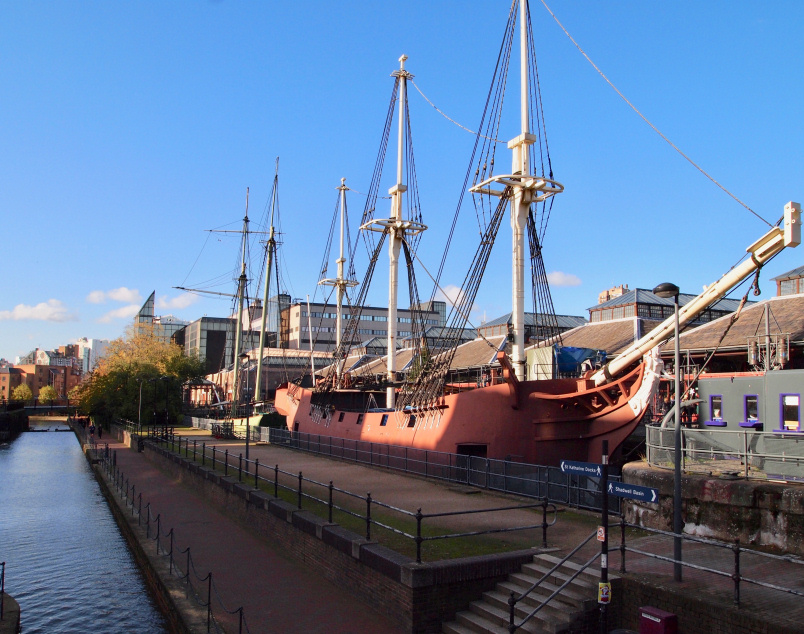
By the mid-1830s over 45,000 tons a year of tobacco were being imported from all over the world, which obviously needed somewhere safe, secure and dry to be stored. Inside, huge cast iron pillars were used to support the two storeys and roof as this allowed more space for storage.
Despite its size it survived the war time bombing, but as the docks began to close it became disused and laid empty for a number of years and was going to be demolished. However, in the 1980s it began to be converted into the ‘Covent Garden of the East’, and over £47 million was spent on the refurbishment, which had upmarket shops on two levels. It opened in 1989, sadly just at the 90s recession was beginning and it never took off and was soon closed down.
Fortunately, it is a Grade I listed building, so there are limitations on what redevelopment can be undertaken; English Heritage have said, “We see Tobacco Dock as a future priority because it is too large and important a site to be left standing empty. It is one of the most important buildings in London and if brought back into use it would reinvigorate the whole area.”
Once again there is talk of it again becoming the ‘Covent Garden of the East End’, but this time with hotels and apartments as well as shops. In the meantime, its four acres of space are used for exhibitions – such as the popular gin and craft beer festivals, for conferences and other events and by film companies.
I’ve written a little more about Tobacco Dock in the appendix .
From Tobacco Dock you now need to turn around and walk back down Wapping Lane to the very bottom, then turn left and 200 yards along on the right-hand side you’ll see Wapping station.
Please note – there’s a separate walk that carries on from here to Limehouse and Canary Wharf.
If you like to continue further and do this walk now, then you’ll need to refer to the separate ‘ Wapping to Canary Wharf walk ’ .
Photo credits (and licences): Ivory House, St Katharine Docks , Jacob Gellweiler ( CC BY-SA 4.0 ); The Coronarium , Ian Nash ( CC BY 4.0 ); Alderman Stairs , Dun.Can ( CC BY 2.0 ); Turk’s Head Wapping neon sign, Dave Bleasdale ( CC BY 2.0 ); Captain Kidd , ‘william’ ( CC BY-SA 2.0 ). All other photographs copyright Kevin Abbey. Plan drawing of London Docks by Henry R. Palmer, credit: Bodleian Libraries.
Click to receive email notifications of new walks.
Please tell us your name and email address and we'll let you know when a new walk is published.
Your name Your email address
We won’t contact you about anything else and you can cancel this request at any time.
RELATED LINKS
On this page, most popular sights, tickets & sightseeing passes, things to see and do, from our blog.

OPEN TOP SIGHTSEEING BUSES
London tours, popular tours from london, free self-guided walks.

- Guide to hotel areas
- Bed & breakfast
- Backpacker hostels
- Airbnb London
- Central London tours
- Tours from London
- Hop-on hop-off bus tours
- Harry Potter tours
- Stonehenge tours
- Downton Abbey tours
- Windsor tours
- Cotswolds tours
- Private tours
- Ticket & pass offers
- Central London attractions
- Attractions outside London
- Harry Potter attractions
- Tower of London
- PUBLIC TRANSPORT
- London City
- London Southend
- Southampton
City of London self-guided walk
Stage 1 tower of london to the bank of england.
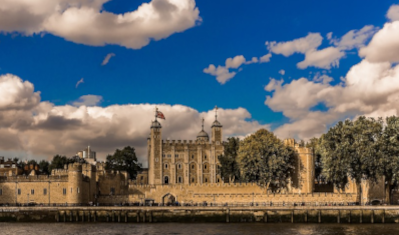
The walk is a circular walk so it doesn't matter really where you start. We have chosen to start at Tower Hill Underground Station, opposite the Tower of London , so you could start here after a morning visit.
Much of this walk is within the old City of London , the original conurbation when it had a city wall. In the City itself it's a ghost town at weekends, so you may choose to do this section of the walk during a working day.
These notes have focus on the logistics, no attempt is made to be a substitute for a good guide book on London.
With a good London street map or map app on your phone you'll have no problem following this walk and be fully equipped to make interesting diversions and adaptations with confidence.
This walk is split over three pages. While this page covers Tower of London to the Bank of England, two other pages cover: Stage 2 Bank to St Paul's Cathedral and Stage 3 St Paul's to Tower Hill
City of London Walk map Getting started The Monument Lloyd's of London The Gherkin Leadenhall Market
City of London Walk map
Getting started from tower hill.
Simply follow the signs over to the Tower of London, descending on the western side of the Tower to the main entrance. There are well maintained public toilets here too. We have a dedicated page for the Tower of London .
The Tower of London marked the south eastern point of the city wall, where it met the river that formed London's southern boundary. The Tower of London is strategically placed to guard against possible enemies, most liable to approach London coming up the River Thames from the sea.
The Romans, about 2,000 years ago were the first to establish London as a city as we would know it today. As now, London then was built on trading and commerce.
Descending to the riverfront, the patch of the River Thames in front of you between Tower Bridge and London Bridge (the next bridge westwards) is known as the Pool of London. This was the original port of London. At that time the river was much wider than it is now and the opposite bank was just marshland.
London Bridge was the original bridge that forded the River Thames, the first crossing point from the sea. For a long time until 1750, London Bridge was the only bridge across the Thames, partly because of the vested interest opposition of the ferrymen that earned a living plying from bank to bank.
The London Bridge in front of you is only about 30 years old. Its predecessor was sold and shipped as a tourist attraction to Lake Havusa, Arizona.
If you are not doing the full walk you might want to go and explore Tower Bridge more closely. Tower Bridge is a relative newcomer, only opened in 1894. Otherwise turn away from Tower Bridge and follow the river path of the north bank westwards. Follow the river path until you approach London Bridge.
Blog: The best free way to experience Tower Bridge .
The Monument
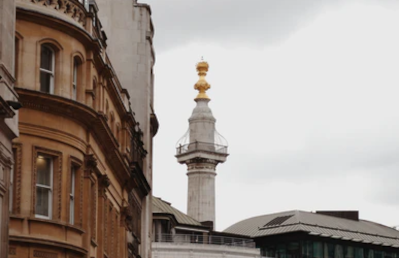
Climb 311 steps for fantastic view of London
Turn right just before London Bridge. Take care to cross the busy road that parallels the river, then climb up Fish Street Hill on the opposite side of the road. Fish Street Hill is the first road northwards for traffic coming east from Westminster after crossing under London Bridge. Keep to the right-hand side of the road the short way until the road bends left. On this bend to your right is the Monument.
In 1666 there was the Great Fire of London, destroying much of London. The Monument is a memorial to that event, its height 205ft, is the same as the distance to the baker's shop in neighbouring Pudding Lane where the fire started.
The Monument is the tallest stone column in the world, topped by a vase of flames. It was designed by Christopher Wren who also was responsible for St Paul's Cathedral which we visit later in the walk.
If you're fit enough you can purchase tickets for a small fee and walk up inside the column (311 steps) for a great view from the top.
Head east (back in the direction of the Tower of London) along Monument Street. In a few yards the first road crossing on Monument Street is Pudding Lane itself. Turn left, up Pudding Lane. The fire that started here destroyed 15,000 homes and 87 churches, much of the city area in 5 days.
Lloyd's of London
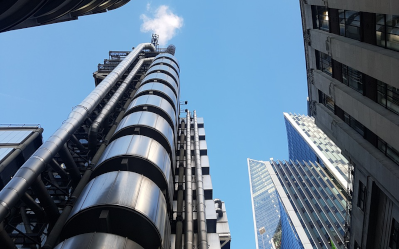
At the top of Pudding Lane, turn right along Eastcheap, then first left up Philpot Lane. In a short while you encounter Fenchurch Street, go straight over. Philpot Lane has become Lime Street.
Follow Lime Street as it bends right and then left. The unmistakable Lloyd's of London building now dominates your attention.
Looking a bit like the Pompidou Centre in Paris, this 1986 building has all its pipes, ducts and lifts on the outside of the building. Originating from a coffee house in the 1860s, Lloyd's is now the world's leading insurance market, covering the most complex and specialist risks, from celebrities body parts to oil rigs.
The Gherkin (30 St Mary Axe)
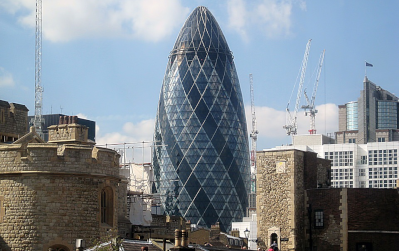
After continuing past the Lloyd's building, the main road crossing is Leadenhall Street. Almost opposite is St Mary Axe Street. From the corner of St Mary Axe opposite the church you have a grandstand view of the colloquially named Gherkin (for obvious reasons) or 30 St Mary Axe.
The Gherkin was completed in 2004 for Swiss Re, the second largest insurance company in the world. It is now privately owned by several offices and is firmly established as one of the icons of the London skyline. It is not the tallest building, but its 41 floors has captured the imagination of the public.
The Gherkin isn’t normally open to the public but you can visit Helix restaurant and Iris bar, which are located on the top floors and have amazing panoramic views across the City of London.
Now retrace your steps, back along Leadenhall Street and turn left into the next road after the Lloyd's building, Whittington Avenue.
Leadenhall Market
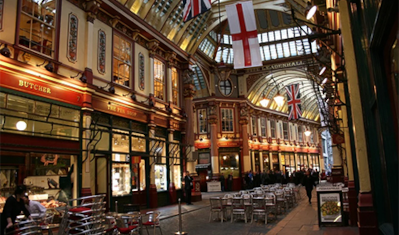
Whittington Avenue leads into the Leadenhall Market complex, a visually very impressive Victorian Market dating from 1881.
The market stands on the site of a Roman basilica. The original market was burnt down in the Fire of London and was then expanded to sell poultry, dairy goods, leather, wool and meat.
It now contains a wide variety of shops and bars. Wander around, a nice place to browse the specialist shops and perhaps take a coffee break.
Make your exit on the western side of the market in Gracechurch Street, the opposite side to your entrance into the market. Turn right up Gracechurch Street to the first main crossroad.
Turn left into Cornhill and follow it for 800m to Bank Underground. Along the way your curiosity will be aroused by the alleys and interesting side lanes. You will be rewarded if you follow your nose down alleys and into churches in a very atmospheric part of London, the oldest. Just return to Cornhill from your adventures.
St Peter upon Churchill Church on the south side of Cornhill is the oldest place of Christian worship in London.
In recent times Leadenhall Market has been used as a filming location for the first Harry Potter film Harry Potter and the Philosopher's Stone.
If you're a Harry Potter fan and you want to visit Leadenhall Market on an organised guided walking tour we can thoroughly recommend the award-winning Muggles Walking Tour in London.
This is the end of Stage one of the London City Walk .
For the other stages please see:
Stage 2 Bank to St Paul's Cathedral
Stage 3 St Paul's to Tower Hill
POPULAR LONDON ATTRACTIONS - ADVANCE PURCHASE AND/OR FAST TRACK TICKETS

- Tour Calendar
- Private Tours
Tower Walk Tour
Proceed booking, already a member.
Username or E-mail
Forget Password?
Don't have an account? Create one.
Adding item to wishlist requires an account, important message.
This walk is a small group tour (maximum group size of 10 participants), which means an intimate and relaxed way to explore London. You can book and join the tour with a group of max 6 people. Please don’t make 2 different bookings if you are more than 6, we won’t be able to allow you on the tour. Send an email instead [email protected] enquiring about a private tour.

- Recommended for all ages
- Not wheelchair friendly unfortunately
- Guaranteed Departure
- No tube/bus ticket is needed
Tower Walk Tour Details
Situated between two of London’s most famous bridges this two hour walking tour offered by Wonders of London begins at London Bridge and ends at Tower of London. Walk through Dickensian streets, explore Borough Market, see the HMS Belfast, take world class photos of the fantastic Tower Bridge and walk over it, see the Tower of London, and walk around St Katherine’s Docks to see some beautiful yachts and the Iconic Dickens Inn. This two hour sightseeing tour is perfect to while away a warm spring day or hot summer afternoon.
Adults – £10
Teens – £8
Children – £5
Meeting Point
Outside London Bridge Underground Station – 21 Duke Street Hill – SE1 2SW ( view on Google Maps )
Ending Location
Tower of London gift shop ( view on Google Maps )
Appointment
15 minutes prior to the starting time
Tower Walk Itinerary
Check out all the stops of our Tower walking tour in this section:
London Bridge Underground Station
View of shard, on london bridge, riverside by no.1 london bridge, hms belfast, tower bridge, dead man's hole, st. katherine's docks, tower of london, tower walk tour map.

View on Google Maps
Photos of Tower Walk Free Tour

Tower Walk Tour Reviews
Had a great Experience with #Tour Guider #Vincet They way he explain everything ,it’s just beyond explanation Worth going to explore #London when you get a chance I can’t wait to go again
Yesterday on the Tower Walk with guide Vincent on a day off. I did contribute as I am earning but it is left up to you whether to contribute. Vincent our guide was great and it was an entertaining 2 hrs. As a Londoner who likes to be local, I thought I knew quite a lot but 80% of the facts I did not know. Worth a look.. each guide does their own tour but can recommend Vincent. Was not forecast good weather but it held out and we had more attention as there were less of us. Based on my experience I would try the other tours too.
When does Tower Walk Tour run?
Tower Walk Tour starts at 7 pm and usually it runs on Tuesday, please check the calendar to find available dates
Where does Tower Walk Tour start?
Our Tower Walk Tour from London Bridge Station in front of Northern Line ticket barriers – SE1 3QX
Where does the tour end?
Our Tower Walk Tour ends at Tower of London gift shop
How long is the tour expected to last?
The Tower Walk Tour lasts for around 2 hours
How will I find the tour guide?
Look for the guide with our unique blue, red and white umbrella with our logo! If you can’t find your guide at the meeting point, click here and you will find the guide’s mobile number, just click on the date on the calendar. Please be aware that the guide won’t check the phone once the tour has started
What happens if it is raining?
We go out RAIN or SHINE, so if it’s drizzling please remember to bring a rain jacket or an umbrella. Only in case of unbearably inclement weather, the tour will be rescheduled and you will be contacted as soon as we can
Can I just show up without booking?
No you can’t, you need to book this tour on this page which takes less than one minute
What does 'Wonders Tour' mean?
Our Wonders Tours are the most particular walking tours of London that will help you to delve deeper into specific aspects of the city. We understand that many of you have travelled various distances to get here, some of you might be locals, some of you might be on holiday here and we know that it can be difficult to enjoy all of London’s best attractions without spending a fair penny. We want our tours to be accessible to anyone and everyone so we charge a low price ticket of just 5£.
Related Tours

London Night Tour Lights & Highlights


South Kensington and The Parks Tour
Privacy overview.
This website uses cookies to improve your browsing experience and analyze the use of the website. Learn More

Walking Across Tower Bridge

This post is about planning a visit to London's Tower Bridge and walking across it.
First and foremost, it's a beautiful bridge that is just begging for your camera to capture it day and night.
It's instantly obvious why it's a great seller for postcards.
Second, it is a bridge and you can use it to get across the Thames. It is totally free to walk across the bridge, the drawbridge anyway.
You can also time your walk to coincide with the lifting of the drawbridge . Both are top free things to do in London .
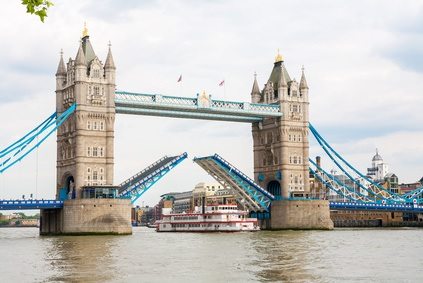
Lastly, you could also walk across the upper-level walkway of Tower Bridge, part of the Tower Bri d ge Experience .
This last option comes with a cost but offers the visitor wonderful views of London 42m (130 feet) above the river (check out the video below).
It also offers the opportunity to learn all about the bridge itself and how it works.
And, in the video below, Sinead, a tour guide with us, Free Tours by Foot , takes you on a virtual tour across the bridge.
So, without further ado, on with the post.
- How to Get Here
- When Does the Bridge Open?
- Nearby Attractions
- Other Things to Do in London
How to Get to London Tower Bridge
TIP: We have a great view of the Bridge in our City of London Tour .
The Tower Bridge is located on the Thames River between the City of London and Southwark nearby the Tower of London, London Bridge, Monument, and City Hall.
You can reach Tower Bridge via the London Underground stations of Tower Hill, Monument, and London Bridge.
We recommend using this Google map for directions to Tower Bridge .
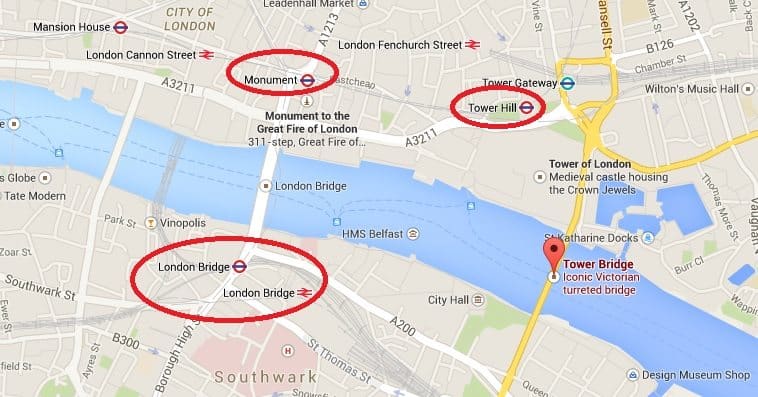
The closest Tube station is Tower Hill, which is serviced by both the Circle and District lines and just a few minutes walk around the Tower of London to Tower Bridge.
London Bridge Tube station, which is serviced by both the Jubilee and Northern lines is approximately a 12-minute walk to the foot of the bridge.
If you mistake it for London Bridge , don't beat yourself up, because you are not alone.
London Bridge is actually a comparatively underwhelming structure slightly up the River Thames.
Constructed in 1894, Tower Bridge is a suspension bridge and a world heritage site.
It measures 244m (801 feet) long and 65m (264 feet) high and provides a roadway across the Thames for over 40,000 people both on foot and on wheels.
It's free to walk across the bridge and to witness its opening and closing, but you will need to buy a ticket for the Tower Bridge Exhibition.
THE TOWER BRIDGE EXPERIENCE
Pedestrian access to the Tower Bridge is available just about any time, but admission to the Tower Bridge Experience will cost extra.
This service allows you to enter the actual bridge itself, see the engines that are used to operate the attraction, and even watch the pedestrians below from glass floors above.
For more details, make sure to read our post covering how to get tickets and what to expect from the Tower Bridge Experience .
When is the Best Time to Visit?
Although you can visit this popular landmark year-round, it can get pretty crowded during popular seasons.
In particular, several travelers report that the Tower Bridge is especially popular during warm summer days.
In order to avoid long waits and lines, you might want to consider a trip during far less popular times.

Crowds also get pretty large during the middle of the day and during weekends, so either an early morning outing on a weekend or a weekday visit might be your best bet.

Several tourists try their best to visit Tower Bridge when the bridge is lifted for a boat to pass.
As a result, it can get pretty crowded while visiting during this event.
Thankfully, the Tower Bridge Experience has provided an app that will allow you to see what this event looks like even if you visit at the wrong time.
With their Raise Tower Bridge app , you can point your phone at the glass floor and simulate the experience of seeing the bridge lift up underneath.
HOW OFTEN DOES THE BRIDGE OPEN
A good way to enhance your visit to the Tower Bridge is to schedule a visit when the bridge opens to allow a vessel to pass by.
The bridge opens and closes approximately 1000 times per year or 3 times per day.
It takes approximately 1 min to open and 1 min to close plus the time it takes a vessel to pass through.
They say it is good luck to see the bridge open because it's not a regular occurrence.
Let Sinead show you the bridge opening in this video below.
The scheduled lift times are posted on the Tower Bridge website .
Ships have up to 24 hours before passing to notify bridge authorities that they will be passing through, so the schedule can change often.
The best place to view the lifting of the bridge is from the riverbanks.
But, it's also possible to view it up close on the bridge itself or inside the Tower Bridge Experience .
Tip 1: If you plan to take photos, consider the time of day that the bridge opens and closes so that you can be sure to be on the best side for light.
Tip 2: The bridge doesn't always open at the posted time, as the vessel passes through maybe early. Be sure to arrive 10-15 minutes before the scheduled raising.
For more tips, check our post about when the Tower Bridge lifts .
WHAT TO DO BEFORE OR AFTER YOUR VISIT
The most obvious things to do before or after are to visit the Tower of London , the HMS Belfast , or to head to the top of the Shard.
However, there are some other options. Of course, do check out our post on top things to do in London .
Consider taking our free City of London Tour or our All-in-One Tour , which both end at the Tower of London, near the entrance to the bridge.
We are good at what we do. Just check out the reviews.
The Tower Bridge is also a great place to start a free self-guided bus tour of London .
The route from the Tower Bridge will take you through Southwark to Covent Garden, where you can transfer and continue your voyage into Westminster.
Why not stop at the Mayflower Pub, especially interesting for Americans, as it stands near the landing point where the Pilgrims embarked for the New World?
If you are visiting during a weekday, you could also stop in and visit City Hall .

Choose a Destination... I want them all PLUS general travel tips. Amsterdam Berlin Boston Charleston Chicago Dubai Lisbon London Los Angeles Miami Nashville New York City New Orleans Paris Philadelphia Prague Rome San Francisco Washington DC
About The Author

North America
United kingdom & ireland, middle east & india, asia & oceania.

Historic Denver Walking Tours
LoDo Walking Tour | Capitol Hill Walking Tour | Larimer Square Walking Tour | The Daniels & Fisher Tower Tour | Tour Times and Prices | Group Tours
In purchasing a Walking Tour Ticket, you agree to all terms and conditions. Please view our Ticket Disclaimer Document to read all terms and conditions.
Walking Tours
Our schedule is open to book your walking tour tickets. Reserve your tickets today so you can join us for a tour and explore Denver by foot!
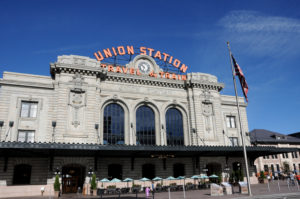
LoDo Walking Tour
From Union Station to Wynkoop, Rockmount Ranchwear to Warehouse Row, learn how the largest collection of historic warehouses in the West transformed from railroad hub to skid row to urban hot spot.

Capitol Hill Walking Tour
Explore the beautiful and charming historic mansions of Capitol Hill and uncover the stories of families who lived in these homes at the end of the 19th century. Tours begins at Molly Brown House Museum.
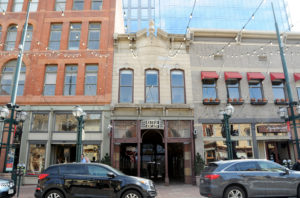
Larimer Square with the Daniel’s and Fisher Clock Tower
With exclusive access to the 1911 D&F Clock Tower on the 16th Street mall, as well as an in-depth look at Denver’s oldest block, Larimer Square, this tour is a delightful way to explore Denver’s early history.
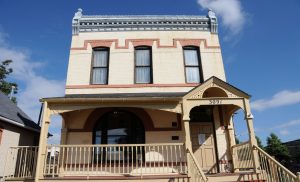
Five Points Walking Tour
Walk along Welton Street with Terri Gentry to learn about the people, places, and neighborhood history. Offered the last Saturday of the month June-Sept

Mansions of Quality Hill Walking Tour
Just south of Capitol Hill is Quality Hill. Boasting architectural gems like the Governor’s Mansion, Malo Mansion and the Zang Mansion, this tour explores the individuals behind the homes, and their legacy in Denver. This tour is offered the 1st Saturday of the month.
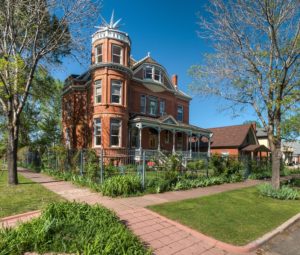
Potter Highlands Walking Tour
Join us to explore the Town of Highlands. Incorporated in 1875, Highlands was promoted as having clean air, clean water and high morals. Explore the mansions, bungalows, cottages and four squares, uncover the families who lived here in late 1800s and early 1900s. Offered the first Saturday of the month May – Oct.

Scavenger Hunt
Back by popular demand, this June we will once again launch our Scavenger Hunt. Follow about a dozen clues and wind your way through Denver’s history, learning about historic buildings along the way. The hunt takes place from June 16-19, and you can participate whenever is convenient for your team. It’s a fun way to uncover more about Denver, while enjoying a fun activity with family, friends, or even on your own.

Private Spaces: Queer Capitol Hill Walking Tour
Explore Queer Capitol Hill with David Duffield, co-founder and coordinator of the Center LGBTQ History Project for Colorado on Colfax. The tour will take guests through Bachelor’s Row and look at how single apartments offered privacy for a closeted community. We’ll explore how public spaces were a refuge and places to connect for LGBTQ people. And we will look at how laws and zoning kept queer Denver heavily policed and segregated. From within the spaces of Capitol Hill came the hearts and activism of generations of queer people. A legacy born of streets, parks, and private spaces.
Staying Safe on Walking Tours
Looking to give the experience of a walking tour, but not sure someone’s preferred tour and date? Grab a gift card from our store, and let them pick out the tour for themselves.
Walking Tour Sponsors

Walking Tour Information
Book your in-person tour today.
In-person guided tours are available for private groups with advanced registration. Contact us and let us know which tour you are interested in, and your preferred date, and we will match your group with a guide that can meet your needs.
All participants and guides will be required to wear masks for the duration of the tour.
To schedule, please email [email protected] .
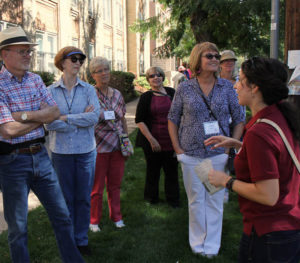
From Union Station to Wynkoop, Tattered Cover to Warehouse Row, learn how the largest collection of historic warehouses in the West transformed from railroad hub to skid row to urban hot spot. The tour starts and ends at the historic Denver Union Station, lasts approximately 90 minutes, and covers about a mile.
Meets in front of Union Station at the Flagpole.
Read reviews from those who have taken the LoDo Walking Tour!
Explore the beautiful and charming historic mansions of Capitol Hill and uncover the stories of families who lived in these homes at the end of the 19th century. This tour begins and ends at the Molly Brown House Museum, lasts approximately 90 minutes, and covers about 1.2 miles.
Meet your tour docent on the sidewalk in front of the Molly Brown House Museum by the Denver Story Trek sign.
Read reviews from those who have taken the Capitol Hill Walking Tour!
Larimer Square Walking Tour With exclusive access to the D & F Tower
At the site of Denver’s founding, you will explore Larimer Square “Then & Now,” learning about the first bustling city center, which eventually turned into skid row. Local citizens saved the block of buildings from demolition, and it became Denver’s first historic district. This tour includes access to the historic Daniels & Fisher Tower where guests will see Denver from the Tower’s 20th floor.
Meet your tour guide at the D&F Tower (1601 Arapahoe St), where the tour will begin. The tour will end at the Kettle Arcade in Larimer Square (1424 Larimer St), after covering about one mile of walking, and lasting approximately 90 minutes.
Read reviews from those who have taken the Larimer Square Walking Tour!
Join us to explore one of the oldest parts of Denver. The Town of Highlands, incorporated in 1875 and was promoted as having clean air, clean water and high morals. On the hill above Denver’s smog of coal smoke, it featured artesian wells and no watering holes, there were no saloons in Highlands until after Prohibition. Many doctors came to Highlands to open sanitariums for those with tuberculosis. Explore the mansions, bungalows, cottages and foursquares, uncover the families who lived here in late 1800s and early 1900s. This tour is a 1.5 mile, level walk.
ADD A REVIEW
Did you enjoy the LoDo, Capitol Hill, or Larimer Square Walking Tour? If so, feel free to add a review here:
TripAdvisor
The Daniels & Fisher Tower Tour For Group Reservations Only
Group Tours of the D & F Tower (8 or more people) may be scheduled year round, in coordination with the Clock Tower’s availability . We ask for two weeks notice to coordinate the tour.
The tour lasts 45-60 minutes.
The Daniels & Fisher Tower Tour will explore the history of Denver, the development of 16th Street as a shopping destination, and the Daniels & Fisher Department Store. Hear William Daniels vision for “a monument by which Denver shall be known”.
Interested in becoming a Walking Tour Docent?
Historic Denver, Inc. partners with VISIT DENVER . You can find additional information on our tours at the Visitor’s Center, 1575 California St., Denver, CO 80202.

- $ 0.00 0 items

Tower of London 3-hour self-guided walking tour and scavenger hunt
Are you looking for things to do around the Tower of London? Try our self-guided walking tour & scavenger hunt to walk this historical district.
Walk from Tower Hill, across Tower Bridge, to City Hall, across London Bridge to St Margaret Pattens Church while seeing monuments. Solve challenges at every stop to learn your next destination. You’ll also learn some local history and fun facts.
Scavenger Hunt information :
What you'll see.
- Tower of London
- Trinity Square Gardens
- Tower Bridge
- Potters Fields Park
- London City Hall
- HMS Belfast
- London Bridge
- St Margaret Pattens Church
- London Wall
- Dragon Statue
- And much more!
Specifications & Requirements
- Starting point: outside the Tower Hill Underground Station, London EC3N 4DJ, United Kingdom
- Distance : 3.4 km / 2.1 mi
- Duration: 3 hours
- Method: walking
- Required: Fully charged smartphone with internet access (data plan) – Wifi will not be enough.
- Water bottle
Ancient History
This area, including London Covent Garden, was inhabited in 4800 BCE as structures have been unearthed through archeology.
The Roman Empire settled the area in around 100 CE and called it Londinium. This lasted until the 5th century.
Then it was the Vikings who initially assaulted the coastlines then settled in north-eastern England until the 11th century.
The city evolved in every sense (architecture, governance, religion, and more) from then on. The population grew rapidly through the centuries, despite losing ⅓ during the Black Death in the mid-14th century.
City of London History
William the Conqueror marched on London, then granted the citizens a charter in 1075. He built here the Tower of London and 2 other castles which are no longer there.
The 16th century saw the construction of the Royal Exchange and the Bank of England. The 18th saw St.Paul’s Cathedral and expansion of the urban area towards the West End and Westminster.
The 19th century brought railways and the Tube, allowing London to expand further out.
The Tower of London Tourist Scavenger Hunt is in development

Prague Old Town walking tour

Florence walking tour

Maastricht walking tour

Tower of London walking tour

Rotterdam walking tour

Amsterdam walking tour

Budapest walking tour

Montmartre walking tour
Privacy Overview
- Lifestyle & Events
- Homes & Amenities
Lifestyle & Events
« All Events
Lewes Historical Society Maritime Walking Tour
April 25 @ 11:00 am - 12:30 pm.
- Google Calendar
- Outlook 365
- Outlook Live
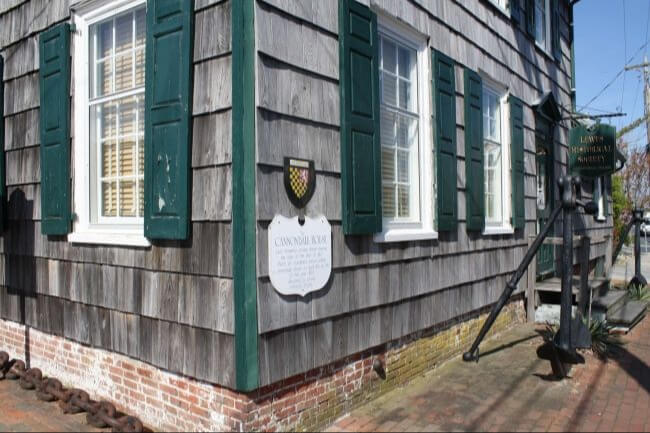

IMAGES
COMMENTS
As you might imagine from its name, Tower Bridge is one of two iconic sights to see - and attractions to visit - in the Tower Hill area. Tower Bridge offers breathtaking views of London's cityscape, including the famous St Pauls, The Shard, and Canary Wharf. Tickets start from £12.30 for adults and £6.20 for children; Tower Bridge is ...
*Except December 24 and December 25. The Jack the Ripper walking tour does not take place on Christmas Eve or Christmas Day. Meeting point: just outside the exit of Tower Hill Underground Station. Your guide - Andy, Molly, Oliver, Simon or Steve - waits for you by the Tower Hill Tram coffee stand, directly outside Tower Hill Underground ...
The walk starts at Tower Hill tube station - which is on the Circle and District lines. Buses Number 15 stops adjacent to Tower Hill Underground station, opposite the Tower of London. The service runs from Trafalgar Square/Charing Cross station, St Paul's Cathedral, Bank station/Queen Victoria Street and Monument station.
Tower Hill: Our most recommended tours and activities. 1. London: Hop-on Hop-off Routemaster Bus Ride. Travel around London and see the sights aboard the world's most famous type of bus - a red London Routemaster. Introduced in 1956 to the streets of London, 2760 of these fine buses operated in the capital until 2005 when the last examples ...
Stage 1 Tower of London to the Bank of England. Start your walk by the Tower of London. The walk is a circular walk so it doesn't matter really where you start. We have chosen to start at Tower Hill Underground Station, opposite the Tower of London, so you could start here after a morning visit. Much of this walk is within the old City of ...
Full description. This wonderful walking tour along London's River Thames gets you up close with some of London's most famous sights, in the company of an expert historian guide! Meeting by the historic, 11th-Century Tower of London, we'll take you across the iconic Tower Bridge and along the banks of the Thames, to step back in time and ...
Outside London Bridge Underground Station - 21 Duke Street Hill - SE1 2SW (view on Google Maps) Ending Location . Tower of London gift shop (view on Google Maps) Appointment. 15 minutes prior to the starting time. ... Tower Walk Tour starts at 7 pm and usually it runs on Tuesday, please check the calendar to find available dates.
Needless to say, the tour ends in the Tower of London, a 2-minute walk from Tower Hill Tube. LONDON WALKS HORS D'OEUVRE "The White Tower, the great keep from which the Tower derives its name, was complete by the end of the 11th century. Even today one can sense the impact this structure must have had when new, towering over the mean timber ...
The tour starts at 3.30pm and 6pm from outside Tower Hill station exit, in front of the Ice Cream refreshments stand. The tour finishes at approximately 5.00pm and 7.30pm, near Liverpool Street Station. Try to solve this gruesome mystery. Follow your expert guide in east London. Walk in Jack the Ripper's footsteps. From £15.00 Book Now.
Experience the remarkable architecture and age-old traditions of the Tower of London and Tower Bridge on a 3-hour walking tour of historic London. Arrive early to view the official opening ceremony of the Tower of London Beefeaters, take a peek at the Crown Jewels before the crowds arrive, then tour the legendary White Tower and hear the tales of torture and execution that the Tower is ...
The closest Tube station is Tower Hill, which is serviced by both the Circle and District lines and just a few minutes walk around the Tower of London to Tower Bridge. ... Wanda B. ★★★★★ Most enjoyable walking tour with Margaret, she was very knowledgeable about the history of London, royalty and landmarks. Margaret told stories in a ...
per adult (price varies by group size) Tower of London for kids & families Private Guided Tour with pre-booked Tickets. 31. Recommended. Historical Tours. from. $360.39. per adult (price varies by group size) Tower of London Private Walking Tour for Families and Friends.
The final attraction on our self-guided South Bank London Walk is the Tower of London. It was founded in 1066, but the white tower that gives the castle its name was built by William the Conqueror in 1078. It was expanded in the 12 th and 13 th centuries to occupy an imposing location by the river Thames and the general layout has remained ever ...
Once we had arrived at the Tower Hill final location, almost all of the group gave up and disappeared (like many of his ghost stories) and the guide seemed genuinely surprised that they had left - despite the fact that the tour was supposed to be 2 hours and by that point it had been over 3 hours. As you can probably tell, it became quite farcical!
Have you ever wondered what is outside every tube station in London. We have challenged ourselves to just that, to walk outside EVERY tube station. All 272. ...
This tour includes access to the historic Daniels & Fisher Tower where guests will see Denver from the Tower's 20th floor. Meet your tour guide at the D&F Tower (1601 Arapahoe St), where the tour will begin. The tour will end at the Kettle Arcade in Larimer Square (1424 Larimer St), after covering about one mile of walking, and lasting ...
Try our self-guided walking tour & scavenger hunt to walk this historical district. Walk from Tower Hill, across Tower Bridge, to City Hall, across London Bridge to St Margaret Pattens Church while seeing monuments. Solve challenges at every stop to learn your next destination.
Walk the Bridge 42 Metre High Walkway, Step onto the spectacular glass floor, Learn the History of Tower Bridge, Visit the Victorian Engine Rooms ... Walking Tours . Windsor Castle, Bath and Stonehenge Tour. London. 11 Hours. Free Cancelation. 5.0 (2) From 105.88. Day trips . London Panorama Open Top Bus Tour with Audio Guide.
This tour demonstrates that "the First Town in the First State" has much to offer to visitors and local alike. Cost: $10.00 per person. Hours: 11:00 AM - 12:30 PM. Meet up location: 110 Shipcarpenter Street, Lewes DE 19958. Parking: The Main Street in Lewes (Second Street) ends at their campus. Parking is to immediate left of their campus ...
🎧 Wear headphones for the best experience.In this video, we will walk through the beautiful streets of old Moscow, as well as visit some new districs.Moscow...
🎧 Wear headphones for the best experience.In this video, we will walk along the famous tourist routes of Moscow, take a walk along the renovated embankments...
🎧 Wear headphones for the best experience.For watching on a big screen 4K.In this video, we will take a walk among the skyscrapers of the Moscow City Intern...
🌆 Hello, everyone! Today, we have a virtual walking tour in the area with Russia's tallest skyscrapers. Here, you can also encounter the most business-orien...